bellwether
Measure of Dedication
The people behind the animals — and the people who got them there
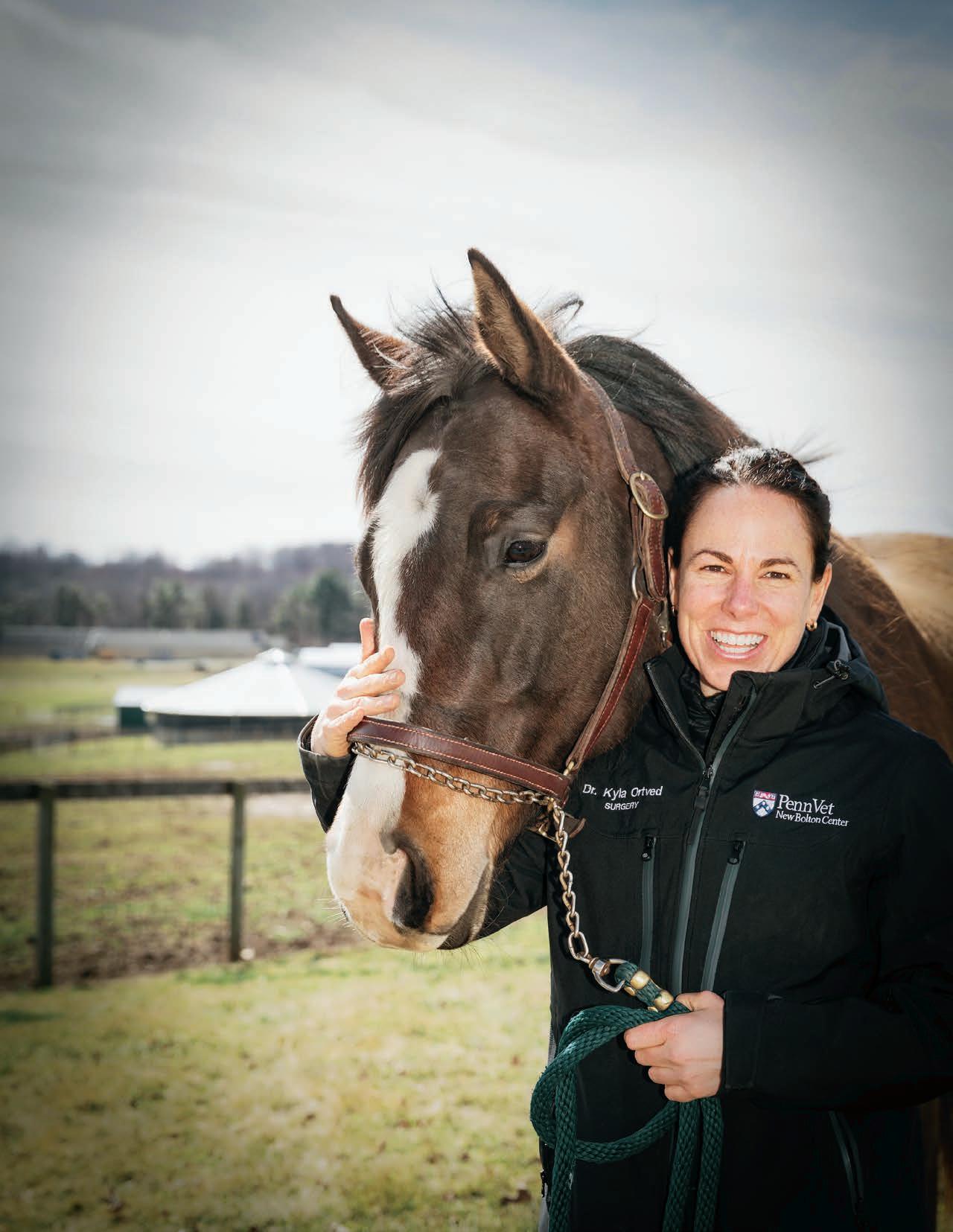
Penn Vet Dual Degrees
The Student Experience Giving is a Marital Affair
Dr. Patricia Mapps, V’96 and Lorin “Jeff” Randall
PEOPLE BEHIND THE SURGERIES AND THE LIFESAVING procedures
they love
SPRING/SUMMER 2021
THE MAGAZINE OF PENN VET
Katie Leonard and Daisy have made multiple trips to Ryan Hospital for Daisy’s care after an altercation with a porcupine. “Penn Vet is the only place we’ll go for our girl,” said Leonard. Read the story, starting on page 6, of Daisy’s ordeal and the dedicated surgeons who’ve helped her in People Behind the Surgeries and the Lifesaving Procedures They Love
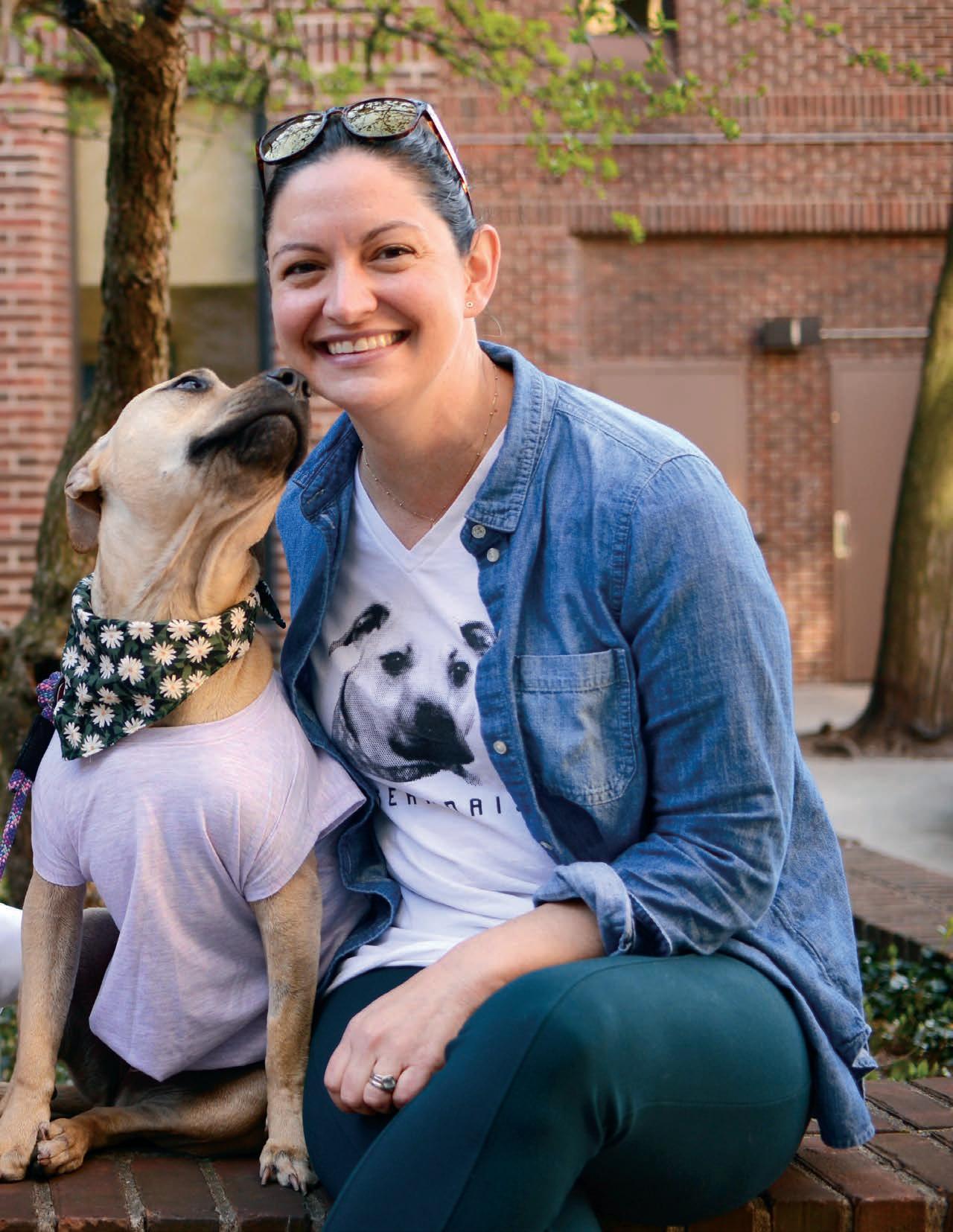
Penn Vet adheres to the CDC mask guidelines. Any unmasked people were vaccinated at the time the photo was taken or standing at a distance of more than six feet from others.
6 People Behind the Surgeries and the Lifesaving Procedures They Love Surgeons, animals, owners — and two complex surgeries with joyful results 14 Penn Vet Dual Degrees: The Student Experience Dual degree programs brought to life by three students 20 Giving is a Marital Affair The Patricia J. Mapps, V’96 and Lorin J. Randall Endowed Scholarship Fund Read Bellwether online at: repository.upenn.edu/bellwether Spring/Summer 2021 #95 2 DEAN’S MESSAGE 22 IN THE OFFICE 24 RESEARCH 26 BOARD OF ADVISORS 27 SCHOOL NEWS 30 FACULTY NEWS 39 STUDENT NEWS 42 ALUMNI NEWS 48 IN MEMORIAM 52 CALENDAR Contents Departments
The human/animal relationship is central to the past year. Adoptions of “pandemic pets” emptied animal shelters. The BBC retelling of James Herriot’s All Creatures Great and Small broke ratings records. And Netflix’s Concrete Cowboy brings much deserved attention — and crowd funds — to Philadelphia horsemen, like the Fletcher Street Urban Riding Club, a group that pairs kids with horses, knowing the deep connection that can develop.
What’s so captivating for me about these stories is the obvious sacred bond between humans and animals. They remind us that veterinary medicine is as much about people as it is animals — the veterinarians who care for earth’s wise and wonderful creatures and the owners who entrust us with care of their companions.
People behind the animals are the focus of this Bellwether . From First Up to Last Word, we share stories of the men and women who make Penn Vet the extraordinary place it is. The issue celebrates their compassion, influence, and skill, honoring
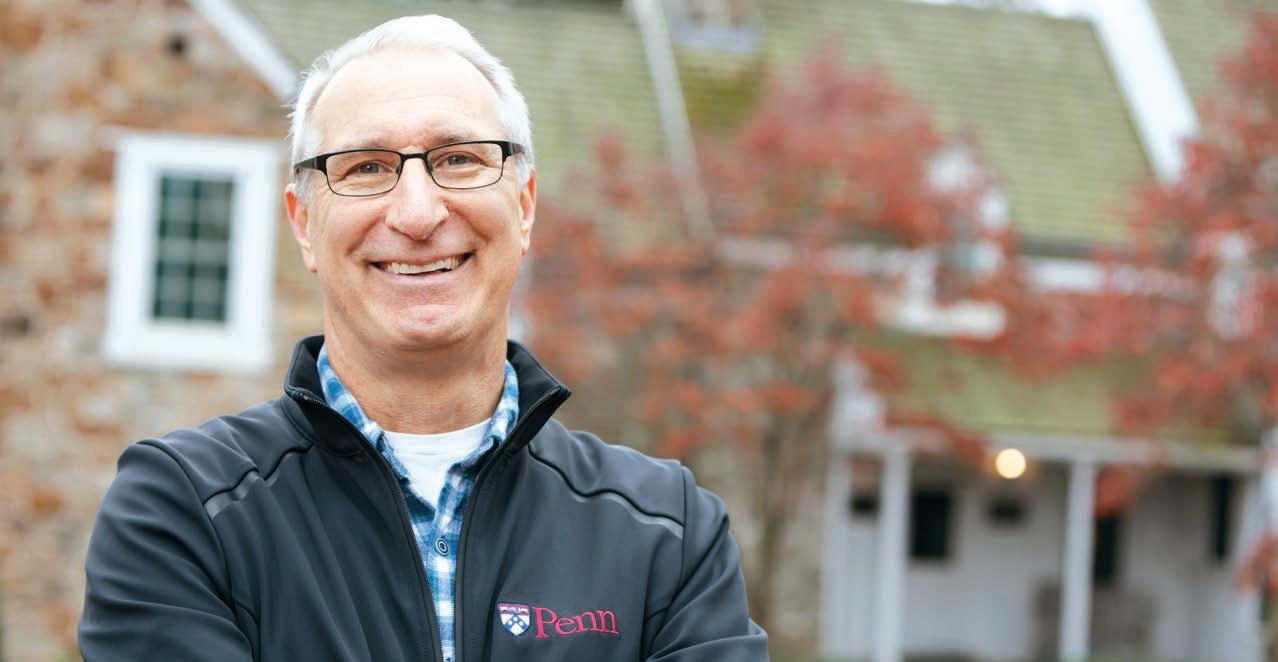
their deep respect and love for the human/ animal bond. It also honors the people behind the people: mentors, role models, partners, and other cheerleaders.
As we saw in the last Bellwether , these people are working in an environment unlike any other in the School’s history.
I’m writing this message weeks after the world marked a year with COVID-19. The Penn Vet team remains resilient beyond words. Our faculty, staff, clinicians, and students continue to adapt to changes in work/home life without wavering in Penn Vet’s mission. I am deeply grateful for them and for our clients, whose love for their animals outweighs any inconveniences of social distance policies that remain necessary for now in our hospitals.
2 BELLWETHER SPRING/SUMMER 2021 DEAN’S MESSAGE
OUR FACULTY, STAFF, CLINICIANS, AND STUDENTS CONTINUE TO ADAPT TO CHANGES IN WORK/ HOME LIFE WITHOUT WAVERING IN PENN VET’S MISSION
DEAN ANDREW HOFFMAN
In the fall/winter issue, I also expressed Penn Vet’s commitment to advancing social and racial equity at the School and in our field. I am pleased to share since then we’ve embedded this promise into the School’s mission statement:
Our mission is to train the next generation of leaders to advance healthcare outcomes and access, ensure global health, bolster sustainable agriculture, create and support interdisciplinary career paths, and foster diversity, equity, and inclusion in the profession
Much more than words, this mission is our roadmap; everything we do touches back to it. The mission holds us accountable, and I am proud that it now makes diversity, equity, and inclusion core to our work.
To support this work, we have also welcomed Rod Gilbert, Penn Vet’s first Chief Diversity, Equity, and Inclusion Officer. Rod is extraordinary and accomplished in organizational diversity and will help strengthen and advance Penn Vet’s vision for diversity representation and inclusion.
Rod and the School’s newly appointed Associate Dean of Institutional Advancement Hyemi Sevening, who joined us in January, both serve on the Dean’s leadership council. I’m thrilled to have them to help guide Penn Vet’s mission
In closing, I want to look back to look ahead. No one is untouched by the events that have unfolded since March 2020 — it has been a challenging period for everyone. We’ve witnessed some of the best of humanity and some of the worst. The strength of the human spirit has been tested again and again and persevered through it all.
As the end of the pandemic slowly comes onto the horizon, and we start to consider life after this crisis, let our connection to each other and to animals — our relationship with all creatures — carry us come whatever may.
EDITORIAL
Editor
Martin J. Hackett
Contributing Editor and Writer
Sacha Adorno
Writers at Large
Katherine Unger Baillie, Martin J. Hackett, Hannah Kleckner Hall
Class Notes Editor
Shannon Groves
Production Manager
John Donges
DESIGN
Designer
Anne Marie Kane, Imogen Design
Photographer at Large
John Donges
Contributing Photographer
Lisa Godfrey
Visual Contributor
Hannah Kleckner Hall
ADMINISTRATION
Gilbert S. Kahn Dean of Veterinary Medicine
Dr. Andrew M. Hoffman

Associate Dean of Institutional Advancement
Hyemi Sevening
Communications Director
Martin J. Hackett
Director of Alumni Relations
Shannon Groves
Director of Annual Giving
Mary Berger
Directors of Development
Margaret Leardi (New Bolton Center)
Helen Radenkovic (Philadelphia)
CHANGE OF ADDRESS
Sarah Trout
Office of Institutional Advancement
School of Veterinary Medicine
University of Pennsylvania
3800 Spruce Street
Suite 151E, Philadelphia, PA 19104 strout@vet.upenn.edu
215-746-7460
Medicine
None of these articles is to be reproduced in any form without the permission of the School. ©Copyright 2021 by the Trustees of the University of Pennsylvania. The University of Pennsylvania values diversity and seeks talented students, faculty, and staff from diverse backgrounds. The University of Pennsylvania does not discriminate on the basis of race, sex, sexual orientation, gender identity, religion, color, national or ethnic origin, age, disability, or status as a Vietnam Era Veteran or disabled veteran in the administration of educational policies, programs or activities; admissions policies; scholarship and loan awards; athletic, or other University administered programs or employment. Questions or complaints regarding this policy should be directed to: Executive Director, Office of Affirmative Action and Equal Opportunity Programs, Sansom Place East, 3600 Chestnut Street, Suite 228, Philadelphia, PA 19104-6106 or by phone at 215-898-6993 (Voice) or 215-898-7803 (TDD).
WWW.VET.UPENN.EDU/BELLWETHER 3
The Gilbert S. Kahn Dean of Veterinary
First Up...
THE VALUE OF THE WHOLE
I am unapologetically shrewd at managing my inbox. I read. I delete. But one recent email I saved. It was Ryan Hospital’s weekly message, which recognizes teams and clinicians for a job well done. I wanted to linger on a particular shout-out.
Tony Nixon, a parking attendant at our Philadelphia small animal hospital, penned a letter to the hospital’s leadership team about what he sees every day in our cramped parking lot off Spruce Street.
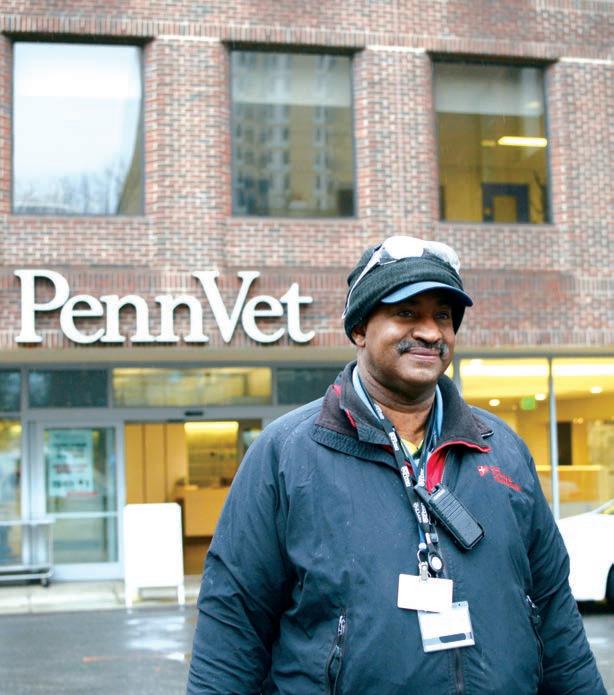
“The School of Veterinary Medicine’s operations are fascinating to watch,” wrote Nixon, a beloved first face many visitors encounter and whose smiles and compassion brighten our days. “I have been told amazing stories of medical accomplishments in the face of seemingly insurmountable medical conditions.”
“This current environment has been a challenge,” continued Nixon. “After all this time, those involved have evolved and risen to the challenges! I’ve seen team efforts grow, pulling together each one’s strengths. In life, you see some are great at counting the parts, but do not understand the value of the whole. This [Penn Vet] team certainly gets the importance of the whole.”
Nixon’s sentiment is a testament to Penn Vet’s unwavering mission — stepping up for the animals we love who give us so much love in return.
So, thank you, Mr. Nixon, and your parking colleague Matt Stanbaugh, for making animals and their humans feel welcome here. And thank you for reminding me that we are all indeed a part of the whole.
Enjoy the issue.
MARTIN J. HACKETT, EDITOR mhackett@vet.upenn.edu
4 BELLWETHER SPRING/SUMMER 2021
Tony Nixon, a member of the Ryan Hospital family and an important “part of the whole.”
SURGERY AT NEW BOLTON CENTER
From advanced orthopedics to soft tissue disorders, your horse’s care is in the hands of surgeons equipped with groundbreaking, innovative techniques and unparalleled capabilities. Surgical excellence. Here, everyone gets it.
To make an appointment, call 610-444-5800 or visit us online at vet.upenn.edu/newboltoncenter

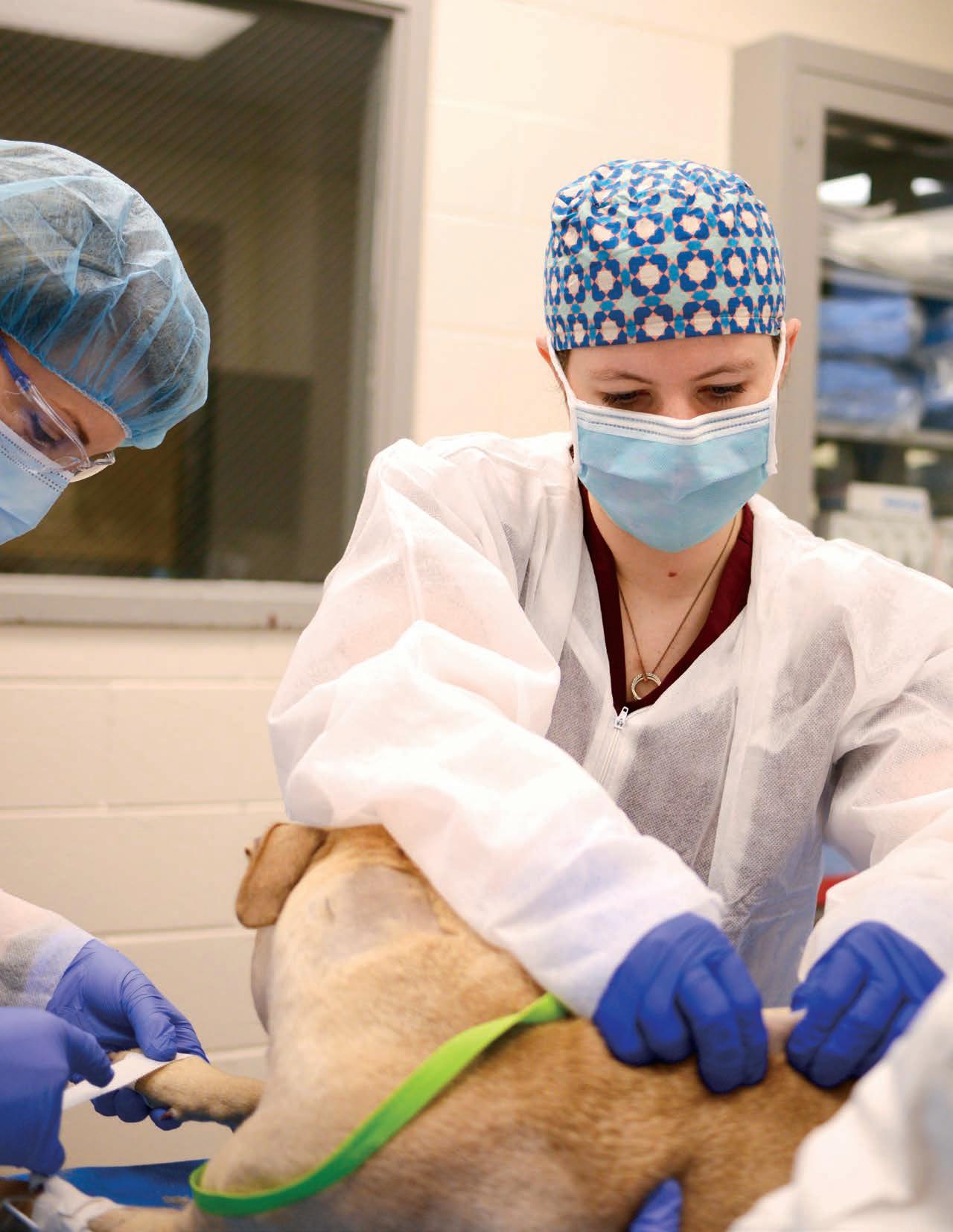
6 BELLWETHER SPRING/SUMMER 2021
By Sacha Adorno
People behind the surgeries and the lifesaving procedures they love

New Bolton Center’s Dr. Kyla Ortved (pictured on the front cover) and Ryan
Hospital’s Dr. Chiara Curcillo (pictured left) continue Penn Vet’s tradition of pioneering veterinary surgery in two complex cases with tenuous prognoses and joyful results.
WWW.VET.UPENN.EDU/BELLWETHER 7
Daisy, seen here with her care team, visits Ryan Hospital for a progress check.
Some advice is best ignored. Like the warning Dr. Kyla Ortved received while volunteering in a small animal clinic as a teenager. One of the clinicians told her vet school was too hard to get into. The woman recommended Ortved do something else.
Fortunately for horse owners, students, and veterinary science in general, Ortved paid little attention. Twice board-certified — by the American College of Veterinary Surgeons and the American College of Veterinary Sports Medicine & Rehabilitation — today Ortved is a rising star in equine sports medicine and large animal surgery. And she runs the Ortved Laboratory at New Bolton Center, which studies post-traumatic osteoarthritis and explores regenerative medicine therapies to benefit horses and humans.
“I have a very specific memory of when I decided to specialize in surgery,” said Ortved, Jacques Jenny Endowed Term Chair in Orthopedic Surgery. “During one of my externships, a resident invited me to participate in a procedure. The horse was under anesthesia for a check ligament desmotomy, a surgery to cut the check ligament for club feet. I helped with the surgery and realized: ‘This is it.’ And it still is. When I am doing surgery, I lose track of time. I’m where I’m meant to be.”
EXCEPTIONAL CARE FOR THE SEVEREST CASES
Recently, this place was with Osada, a two-month-old Friesian with a left tibial fracture.
“She was kicked by another horse,” said Daniel Lapp, owner of Red Crest Stables and breeders in Gordonville, Pennsylvania. “Our vet came to the farm to check her and asked if we’d want to pursue surgery, although she said it was a long shot.”
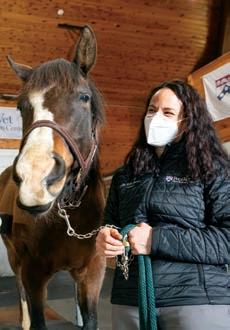
Lapp thought a long shot better than no shot, and the referring vet sent Osada’s X-rays to Ortved for an opinion.
“It was a really severe fracture that was complicated by a second fracture at the growth plate at the top of the bone,” said Ortved. “In foals we usually see one or the other but rarely both. I knew it would be a bit more challenging to repair.” She put Osada’s prognosis at 50 percent.
“I said go for it,” recalled Lapp.
GOING FOR IT
The New Bolton Center surgical team, which included radiology and anesthesia specialists and surgical nurses, prepped the horse. Dr. Dean Richardson, the Charles W. Raker Professor of Equine Surgery, also scrubbed in.
Osada was placed under general anesthesia. Two long, locking compression plates were carefully screwed into the bone in two places, a fracture repair approach for
8 BELLWETHER SPRING/SUMMER 2021
Dr. Kyla Ortved
Members of Osada’s care team (l to r): Dr. Amanda Watkins, Dr. Alycia Crandall, Dr. Angela Gaesser
humans that Richardson adopted for equines early in his career.
After a lengthy, complex procedure — “the tibia is a hard bone to work with because access is difficult,” explained Ortved — they closed the incision in several layers, covering it with a light bandage.
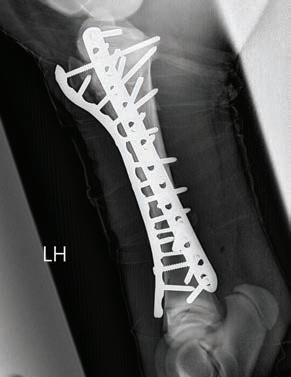

The filly sailed through the surgery and subsequent recovery, but she wasn’t out of the woods. “The thing we’re most worried about in these cases is the implant becoming infected and the repair staying together,” Ortved said.
To mitigate chance of infection, Osada received antibiotics, as well as anti-inflammatory medication and morphine for pain.
A few days post-op, Ortved’s fears came true. The wound opened and fluid leaked from Osada’s leg. “We cleaned the incision and placed a wound VAC over it to help with drainage,” she said. A bacterial culture found infection, so Ortved changed the horse’s antibiotics.

When Osada’s comfort didn’t improve, Ortved took her back to the operating room to lavage the wound. “She had an infection in the joint. We flushed the joint and placed antibiotic-impregnated bone cement in the wound to help with healing.”
The treatment worked. The wound started to close, and Osada slowly improved. She was discharged a few weeks after her last procedure.
WWW.VET.UPENN.EDU/BELLWETHER 9
“It was a really severe fracture that was complicated by a second fracture at the growth plate at the top of the bone.”
DR. KYLA ORTVED JACQUES JENNY ENDOWED TERM CHAIR IN ORTHOPEDIC SURGERY
21ST-CENTURY SURGERY
“In the horse world, many people still think that fractures mean euthanasia,” Ortved said. “One of the takeaways from Osada’s case is that over the past several decades there have been so many advances in nursing care materials, in anesthesia, in surgical approaches that fractures don’t have to mean death. There are more options today.”
Cases like this one and legends like Richardson are among the top reasons Ortved joined New Bolton Center’s clinical team and faculty in 2016. A world-renowned surgeon, Richardson recently received the American College of Veterinary Surgeons ACVS Founders’ Award for Career Achievement for “contributions over the last 30+ years [that] have greatly impacted the art and science of veterinary surgery.”
Ortved said, “Working with Dean is an incredible opportunity and has vastly outweighed my expectation. I am unable to even come close to quantifying what I have learned at New Bolton Center and from him in the last five years.”
RAISED ON SURGERY
Ryan Hospital surgical resident Dr. Chiara Curcillo has conducted fewer surgeries than Ortved. But she has been around the specialty for many years, in a sense having grown up at Penn Vet.
Curcillo’s physician parents pioneered a single incision, minimally invasive laparoscopic surgical technique for humans. Dr. Jeffrey Runge brought it to animals when he was an assistant professor of surgery at Ryan Hospital.
“My parents would help Dr. Runge with the early procedures and take me along for the ride, knowing I wanted to be a veterinarian,” said Curcillo. “Dr. Runge guided me to where I am today. I spent several years shadowing him in the operating room [OR] and on the clinic floor. Having two surgeons raise me and a surgeon as my mentor made me want to be a surgeon and spend my days in the OR just like them.”
QUILLS, QUILLS, AND MORE QUILLS
Curcillo had one of her trickiest surgeries yet this year with Daisy, an American Staffordshire Terrier who had an altercation with a porcupine right after Thanksgiving. The run-in resulted in what has come to seem like an endless number of quills stabbing the dog’s face and traveling throughout her body.
“We were visiting rural New York State and took her to an ER immediately, where they removed quills from all over her face and body,” said Katie Leonard, who, along with her husband, Franklin Donn, adopted Daisy in 2019. “As soon as we picked her up, we noticed more quills poking from her chin and pulled them.”
10 BELLWETHER SPRING/SUMMER 2021
Additional quills surfaced when the couple, along with Daisy and Daisy’s canine brother Dexter, returned home to Baltimore. But more worrisome symptoms overshadowed the quill appearances. Daisy’s breathing was labored, and she had lost interest in food and water.
At an ER in Baltimore, she was diagnosed with a pneumothorax, a dangerous condition of air in the chest cavity that can cause the lungs to collapse if untreated. Using a minimally invasive procedure called thoracocentesis, the ER vet placed a needle through Daisy’s chest wall into her chest cavity to remove air. Daisy was referred to a specialty practice, the third vet stop at this point.
FOURTH STOP IS THE FINAL STOP
“Given the complexity of Daisy’s case, this last veterinarian then referred Daisy to us for further imaging and surgery,” Curcillo said.
This was the hope the family needed. “We weren’t feeling confident until we got to Ryan,” said Leonard. “Dr. Curcillo was very clear about the severity of Daisy’s situation but optimistic that all was not yet lost.”
After sedating the canine under general anesthesia and conducting a CT scan, Curcillo and Dr. Lillian Aronson, professor of surgery, opened Daisy’s chest and abdominal area. Dr. David Holt, professor of surgery, offered a hand.
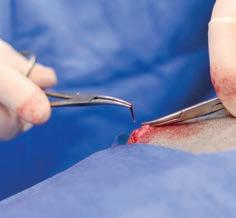
Inside, the surgeons found a body riddled with quills — they were in the heart, lungs, liver, spleen, pancreas, kidney, diaphragm, and body wall. “We removed each gingerly,” said Aronson. “We identified penetrating wounds in one of her lung lobes and performed a lung lobectomy. And we leak tested the other lobes, repairing a defect in one.” Before finishing the procedure, they placed a chest tube to help expel air.
Curcillo had one of her trickiest surgeries yet this year with Daisy, an American Staffordshire Terrier who had an altercation with a porcupine right after Thanksgiving.
Dr. Chiara Curcillo removes a quill from Daisy’s body. The dog would have more than 100 quills removed over many months.
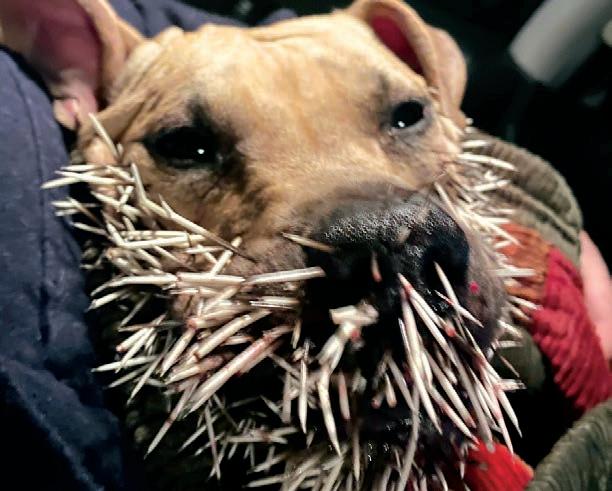
WWW.VET.UPENN.EDU/BELLWETHER 11
Curcillo was working alongside the best: Aronson is a pioneer in small animal surgery and one of the first veterinarians in the world to perform renal transplants in dogs and cats — she’d conducted hundreds long before other surgical practices did any.
Also a noted small animal surgeon, Holt made news recently for charting an innovative approach to cancer surgery that helps surgeons clearly see whether they’ve left any diseased tissue behind in cancer excision surgery.
AN ORDEAL CONTINUED
Post-op, Daisy woke up from anesthesia uneventfully and was transferred to the intensive care unit for monitoring. But, as with Osada, another hurdle was soon to come.
Day three after surgery, she developed abdominal discomfort and had fluid in her abdomen, as well as a suspected second pneumothorax.
It was back to surgery. Curcillo and Aronson opened her chest and abdomen again to evaluate the situation. After removing a few migrated quills, they examined her lungs, which had no apparent leaks, and replaced the old tube with a new one.
But air continued to escape post-surgery. In a minimally invasive procedure, “We then inserted an autologous blood patch to seal the sites in her lungs that were possibly leaking,” said Curcillo.
This did the trick. The rest of Daisy’s hospitalization progressed smoothly, and she was discharged a few days later.
A LONG — AND LOVING — JOURNEY
“It’s been a long road for this sweet, outgoing dog,” said Curcillo. “But given her young age and that she is otherwise healthy, we believed this was a well-considered journey to take.”
12 BELLWETHER SPRING/SUMMER 2021
“It’s been a long road for this sweet, outgoing dog. But given her young age and that she is otherwise healthy, we believed this was a wellconsidered journey to take.”
DR. CHIARA CURCILLO RYAN HOSPITAL SURGICAL RESIDENT
Quills continue to surface even months after Daisy’s face-off with the spiky rodent — her owners estimate well more than 100 quills have been removed in total since November. And she has been back to Penn Vet at least five times for follow-ups and removal of aberrant spikes.
“Penn Vet is the only place we’ll go for our girl,” said Leonard. “We have wonderful pet insurance, thankfully. And Drs. Curcillo and Aronson and all of the clinicians who have worked so hard for Daisy are our ‘Team Daisy.’ We adore them.”
For Curcillo, Daisy is an unforgettable pup.
“I don’t know if I’ll ever see another case like this,” she said. “It was intense, challenging, and pretty cool — a perfect example of the type of surgery I’d hoped to experience at Penn Vet. Working next to Dr. Aronson and Dr. Holt is amazing — I am frequently in awe of them during a procedure. They teach me to be a great surgeon and a great educator. I aspire to be half the surgeons and teachers they are.”
“Team Daisy:” Dr. Chiara Curcillo (l) and Dr. Lillian Aronson (r) with their intrepid patient.
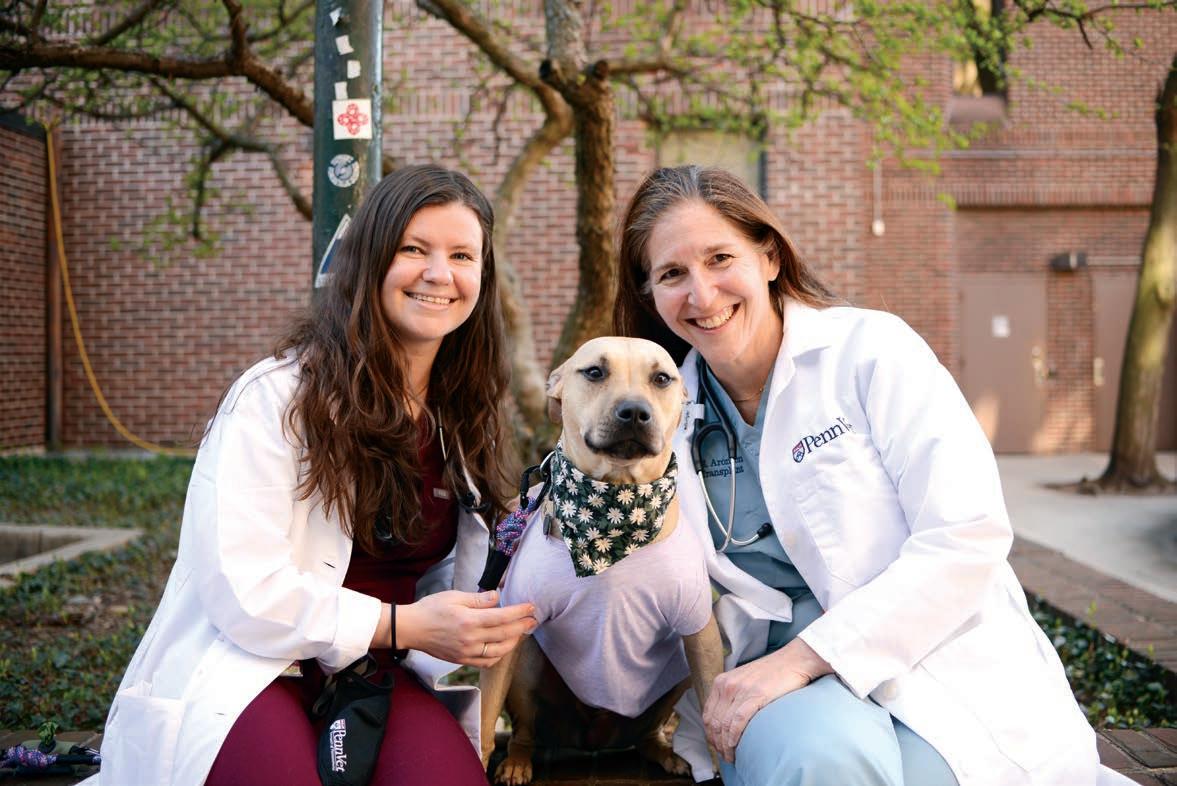
WWW.VET.UPENN.EDU/BELLWETHER 13
Penn Vet Dual Degrees The Student Experience
BY SACHA ADORNO
Last year, Penn Vet expanded its dual degree program, adding a VMD-Master of Social Work (VMD-MSW), with Penn’s School of Social Policy & Practice, as well as a VMD-Master of Environmental Studies (VMD-MES), with the University’s School of Arts and Sciences.
14 BELLWETHER SPRING/SUMMER 2021
The degrees — which feel almost prescient given the recent perfect storm of a pandemic; growing awareness of social, racial and economic inequity; and increased impact of climate change — are the latest additions to the School’s pioneering program. (Penn Vet’s VMD-PhD degree was the first of its kind nationwide.)
“Veterinarians have always played important roles in public health, human health, and welfare. Current events have only underscored the importance of our profession in interprofessional efforts to tackle these complex health challenges,” said Dr. Jennifer Punt, associate dean of One Health and professor of immunology. “These new degrees join the visionary VMD-PhD, VMD-MPH, and VMD-MBA programs and reflect the novel need for veterinarians to engage in interdisciplinary problem solving at the critical juncture of human health, environmental health, and animal health and welfare. Our first cohort of students in these programs are already transforming expectations for the future; we couldn’t be more excited for them and with them.”
Three students — two in the first cohort for the new programs and one in the already established VMD-MPH program — share their experiences as future veterinarians in today’s world.

WWW.VET.UPENN.EDU/BELLWETHER 15
Dual degree students Jaclyn Camus (l) and Anna Shirosky.
Anna Shirosky VMD-MES,
1 2 3 4
How did you come to study veterinary medicine?

Both of my parents were in human medicine. For a time, I wanted to be a human medicine physician. After an internship at an assisted living facility, I realized I didn’t enjoy working with people as much as I expected to. I then had a job as a vet tech doing veterinary physical therapy. That was when I realized I wanted to go into veterinary medicine — I can do medicine and work with creatures that I love as the primary patient.
In what ways do you believe veterinarians can influence environmental protection?
The COVID-19 pandemic has shown veterinarians are at the center of humans, animals, and the environment – it’s the One Health concept. We must embrace our role in balancing the health of all three. Penn Vet’s dual degree programs are an acknowledgment of our unique position, whether we’re in clinical practice, research, or the private or public sector.
Where do you see yourself going with the degree?
It’s all about the environment for me and fish and fish ecology. I’m interested in areas where humans are impacting wildlife, looking at how that interaction is happening, and understanding what people can do to mitigate its harm. I see myself working with a department of game or wildlife.
What has been surprising for you in your MES classes?
The back and forth between perspectives — seeing issues from many different sides and bringing the veterinary viewpoint to environmental issues and the other way around.
For example, in my environmental studies ornithology class, we talked about trap, neuter, release programs, the veterinary gold standard for animal care and population control. I was really surprised environmentalists have a different view — they often advocate for euthanizing stray cats, so the cats aren’t released back into the wild to kill birds and reptiles. I’d never thought of it this way.
I brought the environmental studies view back to my Penn Vet mentors and classmates and the veterinary perspective to my environmental studies classmates. We didn’t solve the issue but did have a more rigorous debate, informed by both sides.
16 BELLWETHER SPRING/SUMMER 2021
’22
Penn Vet’s dual degree programs are an acknowledgment of our unique position, whether we’re in clinical practice, research, or the private or public sector.
1 2 3 4
How did you come to study veterinary medicine?
I studied agriculture in undergrad and worked at a wildlife rehab center when there was an E. coli outbreak that spread to humans. I became fascinated with infectious disease, especially disease between exotic species, and learning more about One Health. I felt Penn Vet was putting One Health into action more than anywhere else — which is evident in the dual degree program options.

What is your vision of the veterinarian’s role in public health?
Someone who is “at the table” in all areas of One Health. I’m interested in areas of the public sector where veterinarians are key to surveillance of diseases that impact animals and humans and have a voice in policies and programs related to curbing disease spread. Penn Vet’s Wildlife Futures Program is a great example. For my capstone project, I’m working with the program to figure out disease surveillance models for chronic wasting disease.
What has surprised you about your MPH classes?
I haven’t been really around my classmates in person because we’ve been virtual, so it’s hard gauge the full experience. But one of the surprises so far is around communication and communication skills.
In vet school, we basically only have time to talk to ourselves and the other vets so it’s easy to slip into vet jargon. My public health classmates are medical students, dental students, nursing students, and undergrads. It’s made me very aware of the need to communicate effectively for a broad audience.
I see it too in the Wildlife Futures Program. A major aspect of the work is outreach to the hunting community to educate hunters about certain practices and policies and get them on board. How we communicate these messages is everything!
Where do you see yourself going with the degree?
I want to go into government, maybe working with the Centers for Disease Control or in a state veterinarian office, probably in research.
WWW.VET.UPENN.EDU/BELLWETHER 17
I felt Penn Vet was putting One Health into action more than anywhere else — which is evident in the dual degree program options.
Jaclyn Camus, V ’22, MPH ’21
1 2 3 4
How did you come to study veterinary medicine?
I was a history major and sociology minor in college. After graduation, I had a ‘what’s next?’ period. My sister pointed out that I enjoyed helping deliver puppies for a friend’s dog. She suggested I look into veterinary medicine. After researching the classwork and animal background I’d need, I worked in a therapeutic riding center while completing a pre-vet post bacc. That changed everything for me and here I am today.
For you, how do veterinary medicine and social work intersect?
Veterinary medicine is really a human-centric profession, whether or not we realize it at first. And social work supports the symbiosis between humans and animals. I see the intersection being the respect and support for the life and dignity of animals and the humans who care for them.
I came into Penn Vet with the goal of helping the animals who help people so much. Then when I learned about the VMD-MSW, I realized this is what I was meant to do –help people and animals!
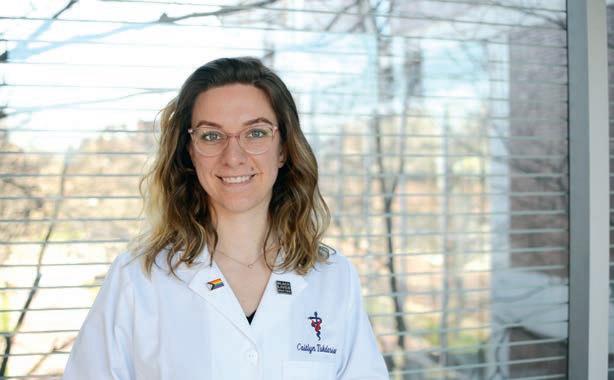
Where do you see yourself going with the degree?
I want to go into equine ambulatory private practice. I shadowed an ambulatory vet and loved that she really got to know the families and their lives. Seeing people and animals in their own environments is a window into what’s going on that you don’t have in a hospital setting. I can help humans and animals all at once. I also want to use my training to expand veterinary medicine into more communities and make care more accessible and equitable for everyone who wants the best for the animals they love.
What has been surprising for you in your MSW classes?
It’s been eye-opening. I took an American Racism in Social Work Practice class. It was the most personally challenging (and necessary) class I’ve ever taken — in the best way possible. We had ongoing interactive journaling exercises that pushed us to confront our personal biases and facts about ourselves we might not have recognized otherwise. I believe anti-racism work that encourages self-reflection is critical to social work and any discipline.
Also, it’s been challenging to shift from more didactic work in the first few years of vet school to more discussion based, theoretical work in social work courses.
18 BELLWETHER SPRING/SUMMER 2021
Caitlyn Tukdarian, V ’22, MSW ’24
Veterinary medicine is really a human-centric profession whether or not we realize it at first. And social work supports the symbiosis between humans and animals.
An Eye on the Students
Chipo Siantumbu manages the student experience across five dual degrees (with more soon to come).
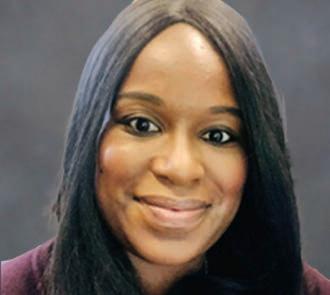
In this role, she gets to know students well while they’re at Penn Vet, often staying in touch after they graduate.
We had questions for her too.
What attracts students to pursue a dual degree?
A passion for the areas they’ve selected is first and foremost. They have a strong interest in interdisciplinary learning and want to mesh their ambitions with classwork to achieve their longer-term goals. And an attractive element, but it’s never been a primary driver, is that Penn Vet offers scholarships to all dual degree students. We guarantee 20% of tuition.
How are students managing the workload of two curricula, some of them simultaneous?
We work closely with our partner schools to identify classes or credits that match within the VMD track and cross count them. So, students end up taking fewer courses than they would going after each degree separately. But the workload is intense; passion can only go so far. We provide supports for students and a mentor for each. I’m proud that all of our students have done extremely well in the vet and secondary degree programs.
And we always encourage students to carve out time for rest and self-care – for example, the students in this piece: Jaclyn is a great baker and
watches horror movie marathons; Anna catches up on sleep, walks her dog and eats dinner with her boyfriend; and Caitlin loves to read, play golf and volleyball, listen to records, and play the piano. They find time to reset.
What differentiates Penn Vet’s dual degree program from others?
Penn Vet is the vanguard. We were the first and have tested experience designing curricula. And Penn Vet dual degree students benefit from studying under the world’s leading scholars, researchers, and educators from multiple disciplines. We recently surveyed a host of dual degree students. Of 19, nine said they chose Penn Vet for the dual degrees, so I’d say the degrees differentiate us from other schools.
I must also add that Penn Vet’s Dr. Jenni Punt [associate dean for One Health] is fantastic — she has translated Dean Hoffman’s vision for these programs into compelling opportunities for students. And she is also a great student advocate — she works closely with students to understand what they need.
WWW.VET.UPENN.EDU/BELLWETHER 19
CHIPO SIANTUMBU, Penn Vet’s One Health Program Coordinator
Giving is a Marital Affair
“I had a ‘midlife crisis’ and would complain to friends about the corporate world,” she said. “They’d ask what I had wanted to do as a kid. I’d say ‘well, I really wanted to be a veterinarian, but I’m too old now.’ Jeff heard me say it and encouraged me to call Penn Vet.”

Jeff is Lorin Jeffry (“Jeff”) Randall, Mapps’s husband of 39 years: “This was obviously something Pat wanted to do — I thought she should at least inquire about the process.”
Mapps made the call, ushering in her next career phase. “I was 44 when I started at Penn Vet, 48 when I graduated,” she said.
She would go on to work in a private practice before starting her own solo practice, which she ran for 15 years before retiring in 2019.
Transitioning from a high-level corporate job to starting over as a student and then small business owner was a welcome change — especially with her
20 BELLWETHER SPRING/SUMMER 2021
MAPPS Philanthropy
PATRICIA
Dr. Patricia Mapps, V’96, was an executive in the technology industry before her second career — and true calling — as a large animal veterinarian.
�Dr. Patricia Mapps, V’96, and husband Lorin Jeffry Randall with their dogs Gabby (l) and Charley.
new job’s “non-cash compensation of driving through beautiful farmlands rather than sitting in an office all day.”
It would have been a different kind of challenge with student loan debt.
“I was very fortunate to have savings,” Mapps explained. “Jeff and I had really good professional jobs, and I was able to pay my way through vet school, which is so unusual. I didn’t graduate worried about debt.”
This fortunate circumstance influenced Mapps and Randall’s giving through a Donor Advised Fund they set-up in the early aughts.
GIFTS THAT MATTER NOW
While Mapps established herself as a field veterinarian, she and Randall, longtime donors to institutions they care about, were also expanding their philanthropic priorities to include Penn Vet.
“We’ve always given to a fairly diverse and pretty long list of organizations in some way,” said Randall, who serves on numerous corporate boards after a career spanning financial and operating roles in biotechnology, pharmaceuticals, and manufacturing.
For Penn Vet, they began with “smaller” annual fund gifts. Their first larger gift was providing for the School in their estate plans.
“A few years ago, we realized we wanted to have the satisfaction of being generous while we’re still alive,” Randall said.
For visible effect, the couple turned to scholarships. “As a grad, I want the School to get the best people,” Mapps said. “It’s hard for almost anybody to easily afford vet school, and there are a lot of really smart, dedicated kids who could go if the money were available to them.”
“But we had no idea how much money it would take,” said Randall. “Once we realized we didn’t have to be multimillionaires to endow a scholarship, we thought, ‘Oh, we can do that! Let’s do that. Let’s help a student along.’”
Two years ago, they established the Patricia J. Mapps, V’96 and Lorin J. Randall Endowed Scholarship Fund.
SUPPORTING AN ‘EXCITING TIME’
The scholarship was awarded for the first time this year to Katelyn Newcamp, V’22, a dual degree student with Penn’s School of Nursing.
“I still cannot believe that I am a third-year student and have the white coat hanging in my closet,” said Newcamp in a letter to Mapps and Randall. “In a few short months, I will be entering clinics and using my newly learned knowledge to care for patients. As I am sure you can remember from veterinary school, it is a very exciting time! I could not be where I am without the incredible support system around me.”
Mapps, who does remember this exciting time of realizing a dream, and Randall, who was by her side through it all, are delighted at Newcamp’s passion. “This is exactly why we wanted to support students,” Randall said.
A PRACTICAL APPROACH TO IMPACT
And they haven’t stopped with scholarships. Wanting to do even more, Mapps and Randall’s most recent gift is equipment at New Bolton Center that will help with laminitis research. “As a former field vet, I’m especially interested in research that is practical,” said Mapps.
Added Randall, “There are so many ways to give. We get great satisfaction seeing the impact in our lifetime.”
WWW.VET.UPENN.EDU/BELLWETHER 21
“It’s hard for almost anybody to easily afford vet school, and there are a lot of really smart, dedicated kids who could go if the money was available to them.”
Dr. Patricia Mapps, V’96
IN THE OFFICE WITH Dr. Eman Anis
HEAD OF THE MICROBIOLOGY LAB AT PADLS
By: Sacha Adorno
When COVID-19 created a global tailspin, Dr. Eman Anis, assistant professor of microbiology, was six months into her appointment at Penn Vet. She joined the School from the University of Georgia in fall 2019.
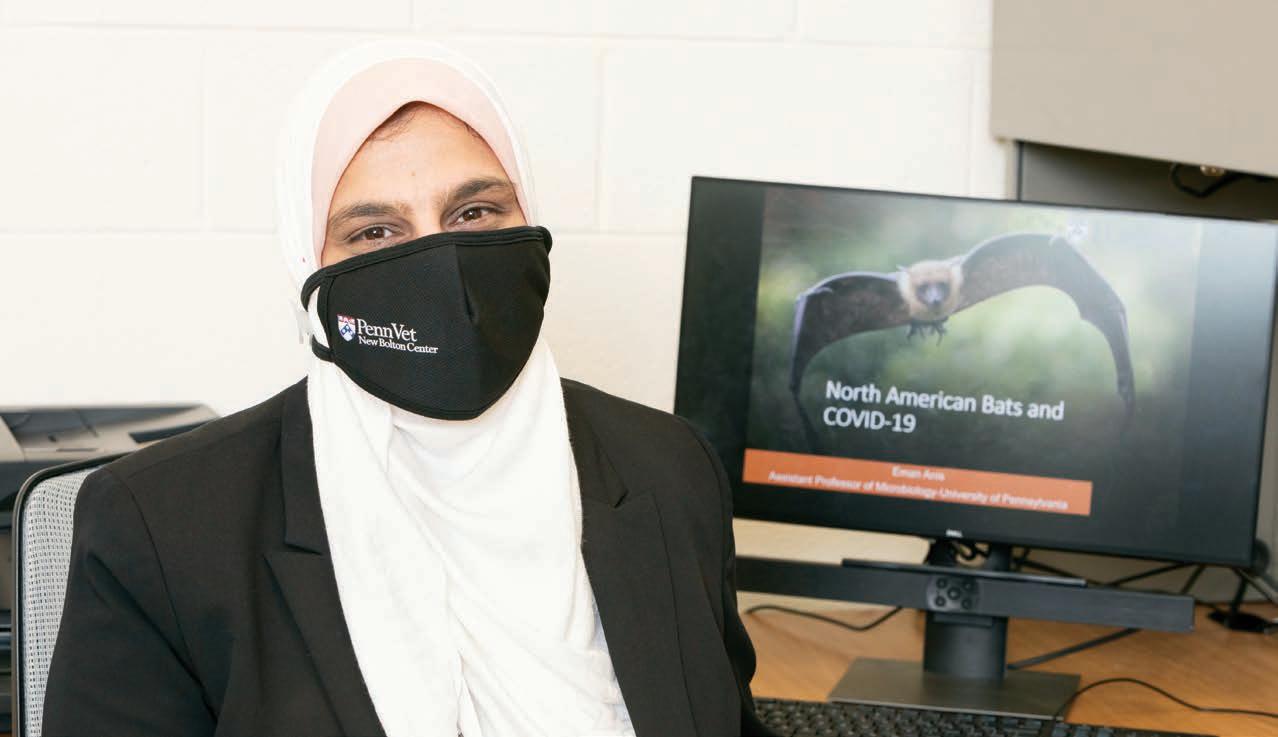
“I was just settling in when the University curtailed in-person operations for the lab,” said Anis, who is also section head of the Microbiology Lab at Pennsylvania Animal Diagnostic Laboratory System (PADLS). The program is a collaboration among Penn Vet, the Pennsylvania Department of Agriculture, and the Pennsylvania State University in wildlife disease surveillance, research, and mitigation.
Early on in the pandemic, Anis’s team worked on a limited schedule to accommodate social distancing, and the full team was back in the lab in June 2020. “We’ve been very busy and demand for our services incredibly high,” said Anis, who has studied coronaviruses since 2010. “Obviously, COVID-19 has put our work into high gear.” (See page 24 for more about Anis’s testing of SARS-CoV-2 in bat guano.)
“I never really got around to ‘decorating’ my office before we started working remotely, and it’s been nonstop since we came back,” she laughed. “My children’s pictures and art are just waiting at home — someday they’ll make it in.”
22 BELLWETHER SPRING/SUMMER 2021 IN THE OFFICE
1. Lab coat. This was the first thing I received when I was hired — with so many people still working remotely I feel so fortunate to be in the lab, wearing my lab coat.
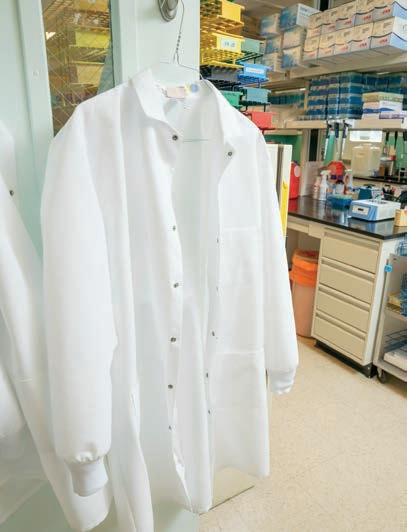
2. Penned welcome. I received this personal handwritten letter from Dean Hoffman soon after I started. It was such a heartwarming gesture to receive when I arrived and means a great deal to me.

3. Extended family. This is my research team at the University of Tennessee — they’re like my extended family. I love seeing their faces when I can’t be with them.
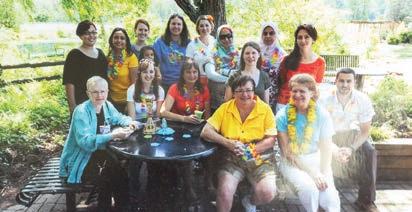
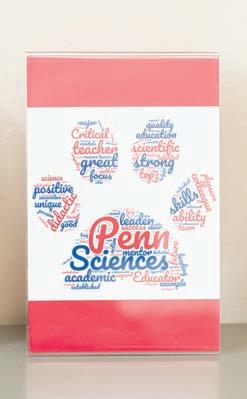
4. Fresh off the printer. Last year, the lab developed a rapid diagnostic test for bat guano and shared it in the Journal of Veterinary Diagnostic Investigation. This development became a critical tool during the pandemic to help prevent additional zoonotic spillover of SARS-CoV-2 and is a body of work that I am particularly proud to have been a part of.
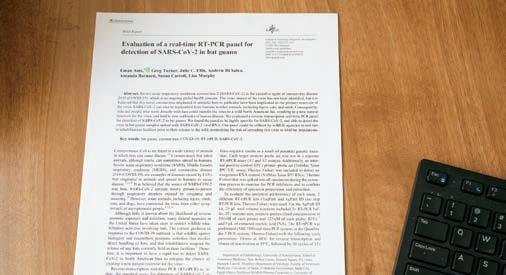
5. Pipe cleaner DNA. At our 2019 holiday party, the lab made this DNA strand. We had no idea in a few months we’d all be socially distant. Even now we can’t gather to enjoy each other’s company as we could before COVID-19 because of social distance protocols. This pipe cleaner is a reminder of the wonderful people I work with, whom I miss.
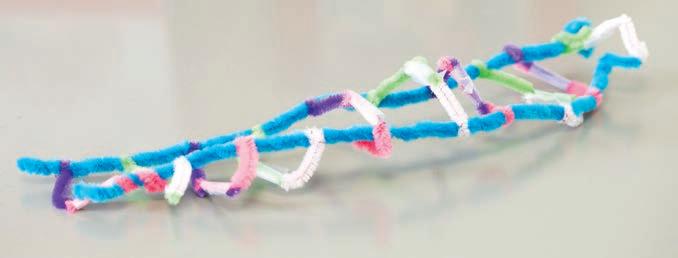
WWW.VET.UPENN.EDU/BELLWETHER 23
2.
1.
3.
2.
4.
5.
“We’ve been very busy and demand for our services incredibly high. Obviously, COVID-19 has put our work into high gear.”
FROM ANIMALS TO PEOPLE AND BACK AGAIN
By: Katherine Unger Baillie
The World Health Organization has stated that the coronavirus “most likely” jumped from wildlife to humans. Though the precise species of origin is still unknown, the risk of zoonotic transmission, or continued crossing between species, is real. What this means for wildlife, pets, and human health is somewhat mysterious, and researchers at Penn are working to shed light on the risks of species-to-species disease movement, while mitigating further transmission.
“It’s scary to think of the spread of a disease from wildlife to humans because if there is spillover back into wildlife populations that could make it hard to contain,” said Dr. Eman Anis, assistant professor of microbiology.
Last year, upon learning that bats were a leading suspect in passing COVID-19 to humans, Anis was worried about the possibility of bats in rehabilitation facilities, where they interact daily with humans, being infected. “This raised some concern about releasing those bats into the wild early in the pandemic,” said Anis. The risk was that they could potentially establish a new reservoir of the virus in wild bats.
She quickly rolled out an experiment to test samples of guano — bat poop — for SARS-CoV-2, the virus that causes COVID-19. Testing 100 bats in rehab facilities around Pennsylvania, Anis was relieved to find all were negative. But the experience also enabled her and her colleagues to refine a diagnostic panel, shared in the Journal of Veterinary Diagnostic Investigation , which may be applied in future testing.
Assuming SARS-CoV-2 did move from bats to humans, the transmission chain didn’t end there, species-wise, as evidenced by the reports of pets and zoo animals becoming sick with COVID-19. Dr. Elizabeth Lennon, the Pamela Cole Assistant Professor of Internal Medicine, has been testing pet dogs and cats for coronavirus, to understand the spread between humans and animals and further study virus’s behavior when it crosses species. Lennon and coronavirus expert Dr. Susan Weiss of the Perelman School of Medicine are studying viral samples from these pets in Penn’s Biosafety Level-3 laboratory.
24 BELLWETHER SPRING/SUMMER 2021
RESEARCH
IN FEBRUARY, IT WAS GORILLAS. BEFORE THAT, IT WAS MINK. AND EARLIER STILL, TIGERS AND LIONS.
ALL OF THESE SPECIES HAVE HAD A COVID-19 DIAGNOSIS.
So far, research has supported the idea that both cats and dogs are susceptible to COVID-19, although less so than humans. Cats appear more susceptible than dogs.
“People are driving the spread of this disease, not pets. But we do want to ask if pets, in certain circumstances, may be more susceptible and shed large amounts of virus.” said Lennon. The findings could help inform disease prevention strategies in animal shelters, veterinary facilities, and even pet owners’ homes.
THE MINK CRISIS
Perhaps no domesticated animal species has borne a greater burden from COVID-19 than mink. Seventeen million were culled in Denmark in November 2020 after outbreaks were identified on hundreds of mink farms.
Sequence data showed the virus had spread from farm workers to mink and then back again, acquiring mutations as it spread. With new, more contagious variants steadily making their way around the globe, the mink outbreak generated understandable fear.
“I think they were taking precautions to protect human health,” said Dr. Scott Weber, V’97, a veterinarian with Penn Vet’s Wildlife Futures Program. “With vaccines coming out, they didn’t want any possibility that a new mutation would make any vaccine less effective.”
To ensure mink farms in Pennsylvania do all they can to protect against infection, the Wildlife Futures Program, a joint effort between Penn Vet and the Pennsylvania Game Commission, helped develop a threat assessment for the state’s mink farms, offering updated information about what was known about the disease to date, as well as guidance to reduce risks.

VACCINATING HUMANS AND ANIMALS
As vaccines slowly roll out to humans, Penn Vet researchers are collaborating with medical scientists, including Penn Medicine’s Dr. Drew Weissman, who pioneered the mRNA technology behind the Moderna and Pfizer COVID-19 vaccines, to develop animal vaccines to support agricultural industries and perhaps pets as well.
“We still have a lot to learn about this virus,” said Anis. “While we learn, we need to be taking all the precautions that we can.”
Listen to our recent webinar, Are Our Pets Really at Risk of Getting COVID-19? , featuring Drs. Shelley Rankin, Elizabeth Lennon, and Deborah Mandell. Go to vimeo.com/pennvet to view the recording.
WWW.VET.UPENN.EDU/BELLWETHER 25
BOARD OF ADVISORS WELCOMES TWO NEW MEMBERS
Penn Vet is pleased to appoint two new members to its Board of Advisors, an advisory body to the Dean. Joining the Board is Roxanne Conisha Bok, C’81 . Bok earned a master’s degree in 19th-century English and American literature at King’s College London. Published in 2011, her book, Horsekeeping: One Woman’s Tale of Barn and Country Life , chronicles Bok’s adventurous and loving restoration of a neglected horse farm in rural Litchfield County, Connecticut. Today, that farm is home to the dressage riding barn Weatogue Stables, a full-service equine facility that Bok now operates. She also raises a thriving herd of 50 grass-fed cattle on the farm. Bok and her family are longtime Penn donors. The Bok Family Professorship in the Humanities in the School of Arts and Sciences was established in 2007 by Bok, her husband Scott L. Bok, C’81, W’81, L’84, and the Bok Family Foundation. In 1996, Bok and her husband created the Bok Endowed Visiting Writers Series Fund. She lives in New York, New York, and on her farm in Salisbury, Connecticut.
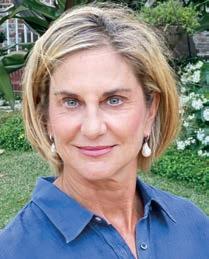
Abigail Kazam, C’02 , also joins the Board. She is the founder and CEO of ASK Consulting with a strong track record building and growing brands in the health and beauty industry. Most recently, Kazam worked with Capsule Pharmacy, Rowan, Estée Lauder, Nudestix, and other brands in bringing them to market, primarily focusing on strategic planning and execution to grow awareness and customer base. Prior to that, she spent eight years at Unilever launching Dove Men and running the Dove brand, including the Campaign for Real Beauty. Kazam holds a BA in communications from Penn and an MBA from the Columbia Business School. She has strong family ties to the University of Pennsylvania. Her mother, Dr. Bonnie B. Kazam, was a 1969 graduate of the College for Women, and her brother, Joshua Kazam, is a 1999 graduate of the Wharton School. Kazam spends her weekends with her family on their Millbrook, New York farm, where she horseback rides every morning with her daughter and two boys, just as she did growing up with her own mother.
“I couldn’t be more excited to have Roxanne and Abigail join our superlative Board of Advisors,” said Mark Spitzer, W’71 , and chair of Penn Vet’s Board of Advisors. “Their expertise complements the Board’s skills and experiences, and I know they will provide valuable perspectives as we continue to assist Penn Vet to advance critical priorities, propel initiatives, and build long-term support for the School.”

26 BELLWETHER SPRING/SUMMER 2021 BOARD OF ADVISORS
Roxanne Conisha Bok, C’81 Abigail Kazam, C’02
BOLSTERING PENN VET’S VOICE AND VISION
TWO NEW LEADERSHIP TEAM MEMBERS
and the communities they serve,” said Gilbert, who before Penn Vet was director of diversity pipeline programs and outreach for the College of Medicine at the Pennsylvania State University. “I look forward to harnessing the School’s collective energy to support our next generation of veterinarians and to build an equitable and sustainable world.”
Penn Vet’s leadership team has two new members. Roderick J. Gilbert, the School’s first Chief Diversity, Equity and Inclusion Officer, and Hyemi Sevening, the new Associate Dean for Institutional Advancement, joined the School staff at the beginning of this year.

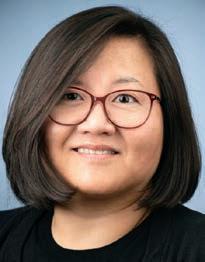
Gilbert is responsible for shaping Penn Vet’s diversity, equity, and inclusion strategy for students and staff; establishing relationships with diversity leads across the University and within the veterinary profession to build awareness of Penn Vet’s inclusion activities; and building upon the School’s foundation of allyship. His appointment accelerates Penn Vet’s efforts to embed diversity, equity, and inclusion across the School’s teaching, healthcare, and research missions.
He serves on the School’s leadership council, working with Dean Andrew Hoffman and Associate Dean of Faculty Affairs and Diversity Dr. Olena Jacenko to foster Penn Vet’s Plan for Faculty Excellence through Diversity.
“It is clear to me that the School’s students, staff, and faculty have an unwavering passion for each other
Sevening, a senior fundraising professional with more than 17 years of development experience, comes to Penn Vet from the School of Veterinary Medicine at the University of California at Davis, where she served as assistant dean of advancement and oversaw the institution’s wide-ranging fundraising efforts.
At Penn Vet, Sevening also serves on the leadership council and is responsible for the overall conceptualization, planning, and execution of a coordinated program of private source fund raising, constituent relations, and communications to support the long- and short-range goals of the School.
“I am thrilled and honored to join Penn Vet, which has a distinguished legacy of translational research and clinical veterinary specialties,” said Sevening. “The School has a dynamic and forward-looking educational mission and a vision for the future of veterinary medicine. As we move into an exciting new decade, I welcome this extraordinary opportunity to work with the entire Penn Vet community in achieving the School’s goals.”
Join us in welcoming these stellar new voices and talents to the School’s leadership body.
WWW.VET.UPENN.EDU/BELLWETHER 27 SCHOOL NEWS
Roderick J. Gilbert Hyemi Sevening
MARKING BLACK HISTORY MONTH
During Black History Month, Dr. Kathryn Waddell Takara was a featured keynote speaking during the Diversity, Equity, and Inclusion (DEI) Council’s event Celebrating Black History Month: Our Past, Our Present, Our Future
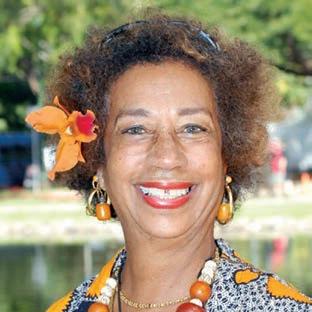
Waddell Takara is the daughter of Dr. William Waddell, V’35 . She reflected on her father’s career and his experiences battling racism over the course of his life. Waddell served on the faculty at Tuskegee University and later co-founded Tuskegee’s School of Veterinary Medicine with Dr. Frederick Douglass Patterson.
Student participants also openly shared their experiences at Penn Vet, helping to drive open dialogue on racism and DEI. Penn Vet’s Dr. De’Broski Herbert moderated the program, and Chief Diversity, Equity and Inclusion Officer Roderick Gilbert shared his vision for our future.
PFIZER CEO DR. ALBERT BOURLA ADDRESSES GRADUATES
Albert Bourla, DVM, PhD, chairman and CEO of Pfizer, delivered the keynote address at Penn Vet’s Commencement, held virtually on May 17. A veterinarian by training, Dr. Bourla leads Pfizer in its purpose: breakthroughs that change patients’ lives, with a focus on driving the scientific and commercial innovation needed to have a transformational impact on human health. This was most evident in Pfizer’s development of one of the first COVID vaccines, a critical tool in addressing the current global pandemic.
“Dr. Bourla encapsulates the unique and impactful role of veterinarians as practitioners of One Health on a global scale,” said Dean Hoffman. “His perspective is particularly germane to our graduates as they embark upon their careers in this noble profession, with the knowledge and sensibility to explore all options that lie ahead.”

28 BELLWETHER SPRING/SUMMER 2021 SCHOOL NEWS
Dr. Kathryn Waddell Takara
Dr. Albert Bourla
NEW BELLWETHER SESSIONS
VIRTUAL EVENTS CONNECTING VETERINARY EXPERTS, PET OWNERS, AND BEYOND
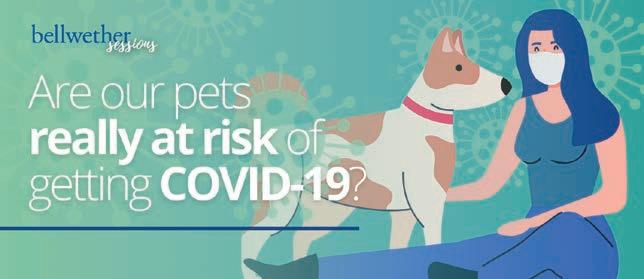
Amid the throes of the COVID-19 pandemic, the need to stay connected, both with one another and with reputable, evidence-based sources, soared. Enter Penn Vet’s Bellwether Sessions — a new virtual event series designed to engage and connect alumni, hospital clients, pet owners, and beyond with leading Penn Vet expertise delivered directly through the convenience — and safety — of home.
Since its inaugural event in September 2020, the growing series of interactive, discussion-based webinars has garnered the attention of more than 1,000 attendees, delivering critical insights from Penn Vet faculty on timely, relevant topics, such as the implications of the workfrom-home environment on pet behavior; how Ryan Hospital’s Shelter Medicine program responded to the pandemic; and, most recently, whether or not COVID-19 is a legitimate threat to our four-legged family members.
The virtual events, an extension of the Bellwether magazine brand, embody the best of what Penn Vet has to offer: applicable, evidencebased solutions for real-time, life-altering challenges that transcend across human, animal, and environmental health, and society.
Bellwether Sessions participants — now able to gain access to these events unincumbered by their physical geographical location — are offered the unique opportunity to hear directly from leading Penn Vet faculty and clinicians, and then have their own questions answered live during each seminar.
With upcoming sessions being planned for fall 2021, the Bellwether Sessions series is open to all and free to attend. Follow Penn Vet on Facebook or Instagram for event announcements (@pennvetschool).
WWW.VET.UPENN.EDU/BELLWETHER 29 SCHOOL NEWS
PENN VET EXPERTISE DELIVERED DIRECTLY THROUGH THE CONVENIENCE — AND SAFETY — OF HOME.
FACULTY & STAFF UPDATES
Gary Althouse, DVM, PhD , chaired the Boar Studs and Herd Breeding Performance seminar at the virtual 52nd Annual AASV Meeting. He also presented Avoiding disruption to the semen supply chain .
Jorge Alvarez, PhD , published Benallegue N, Kebir H, Kapoor R, Crockett A, Li C, Cheslow L, Abdel-Hakeem MS, Gesualdi J, Miller MC, Wherry EJ, Church ME, Blanco MA, Alvarez JI, “The hedgehog pathway suppresses neuropathogenesis in CD4 T cell-driven inflammation,” Brain, 2021, https://doi.org/10.1093/ brain/awab083. He also published
Casella G, Rasouli J, Thome R, Descamps HC, Vattikonda A, Ishikawa L, Boehm A, Hwang D, Zhang W, Xiao D, Park J, Zhang
GX, Alvarez JI, Rostami A, and Ciric B, “Interferon- γ / Interleukin-27 Axis Induces
Programmed Death Ligand 1
Expression in Monocyte-Derived Dendritic Cells and Restores
Immune Tolerance in Central Nervous System Autoimmunity,”
Frontiers in Immunology , 2020, https://doi.org/10.3389/ fimmu.2020.576752.
Zhengxia Dou, PhD , presented as part of Climate Week at Penn, The Farm of the Future Series, and the Penn in China Faculty Speaker Series: The Future of Food in China. She published Liu L, Guo Y, Tu Y, Zhang N, Bai Z, Chadwick D, Dou Z, and Ma L, “A Higher Water-Soluble Phosphorus Supplement in Pig Diet Improves the Whole System Phosphorus Use Efficiency,” Journal of Cleaner Production , 2020, https://doi.org/10.1016/j. jclepro.2020.122586. She also published Wang X, Dou Z, Shi X, et al., “Innovative Management Programme Reduces Environmental Impacts in Chinese Vegetable Production,” Nature Food , 2020, https://doi. org/10.1038/s43016-020-00199-0. She also published Dou Z, Stefanovski D, Galligan D, Lindem M, Rozin P, Chen T, and Chao A, “The COVID-19 Pandemic Impacting Household Food Dynamics: A Cross-National Comparison of China and the U.S. Frontiers in Sustainable Food Systems,” Frontiers in Sustainable Food Systems , 2021, https://doi. org/10.3389/fsufs.2020.577153. She also published Dou Z and Toth J, “Global Primary Data on
Monserrat Anguera, PhD , was named a Penn Fellow for 2020–2021. The Penn Fellows Program provides leadership development to select Penn faculty in mid-career. Begun in 2009, it includes opportunities to build alliances across the university, meet distinguished academic leaders, think strategically about University governance, and consult with Penn’s senior administrators.
Consumer Food Waste: Rate and Characteristics, a Review,” Resources, Conservation, and Recycling , 2020, https://doi. org/10.1016/j.resconrec. 2020.105332. She also published Dou Z, “Leveraging Livestock to Promote a Circular Food System,” Frontiers of Agricultural Science and Engineering , 2020, https:// doi.org/10.15302/J-FASE-2020370.
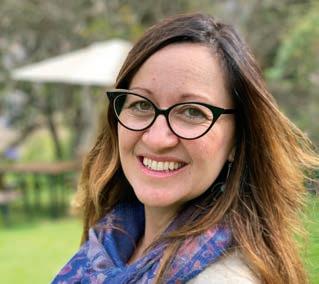
30 BELLWETHER SPRING/SUMMER 2021
FACULTY NEWS
Bernd Driessen, DVM, PhD, Dipl. ECVPT, Dipl. ACVAA and Klaus Hopster, DVM, PhD, Dipl. ECVAA completed the 2020 Equine Anesthesia, Analgesia and Perioperative Care Program, a three-module certificate course for European equine practitioners and veterinary nurses organized with logistical assistance from VetBloom/Ethos Veterinary Health and Narkovet Consulting. The two anesthesiologists from New Bolton Center were joined by Charlotte Hopster-Iversen, DVM, PhD, Dipl. ECEIM and Associate Professor of Large Animal Internal Medicine at Copenhagen University (DK), who taught about neonatal diseases and perioperative care of the foal. The course was offered virtually because of the COVID-19 pandemic; the online format will continue in the future with the intent of reaching more equine veterinarians and veterinary nurses.
Raimon Duran-Struuck, DVM, PhD, DACLAM , was promoted to associate professor (CE) in the Department of Pathobiology. He published Matar AJ, Crepeau RL, and Duran-Struuck R, “Cellular Immunotherapies in Preclinical Large Animal Models of Transplantation,” Journal of Biology of Blood and Marrow Transplantation , 2020, https:// doi.org/10.1016/j. bbmt.2020.09.032.
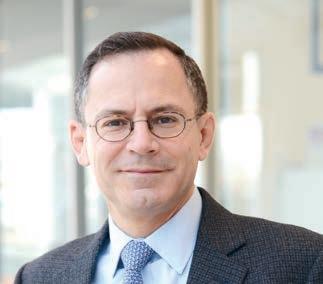
Diane Eigner, VMD, MBA , is president-elect of the International Association of Animal Hospice and Palliative Care. Her company, The Cat Whispurrr, offers end-of-life care for cats.
Ronald Harty, PhD , published Liang J, Ruthel G, Sagum D, Bedford M, Sidhu S, Sudol M, Jaladanki C, Fan H, Freedman B, and Harty R, “Angiomotin Counteracts the Negative Regulatory Effect of Host WWOX on Viral PPxY-Mediated Egress Host Regulation of Viral PPxYMediated Egress,” Journal of Virology , 2021, in press.
Rebecka Hess, DVM, MSCE , published O’Kell AL, Wasserfall CH, Henthorn PS, Atkinson MA, and Hess RS, “Evaluation for Type 1 Diabetes Associated Autoantibodies in Diabetic and Non-diabetic Australian Terriers and Samoyeds,” Canine Medicine and Genetics , 2020, https://doi. org/10.1186/s40575-020-00089-5. She also published Mui ML, Famula TR, Henthorn PS, and Hess RS, “Heritability and Complex Segregation Analysis of Naturally Occurring Diabetes in Australian Terrier Dogs,” PLOS ONE , 2020, https://doi.org/10.1371/journal. pone.0239542. She also published Shea EK and Hess RS, “Assessment of Postprandial Hyperglycemia and Circadian Fluctuation of Glucose Concentrations in Diabetic Dogs Using a Flash Glucose Monitoring System,” Journal of Veterinary Internal Medicine , 2021, https://doi. org/10.1111/jvim.16046.
Katrin Hinrichs, DVM, PhD, Dipl ACT , received the 2020 Research Award from the American Association of Equine Practitioners. Hinrichs was also awarded an honorary doctorate from Belgium’s Ghent University for her research in the field of equine ART.
WWW.VET.UPENN.EDU/BELLWETHER 31
William Beltran, DVM, PhD , was elected to the National Academy of Medicine (class of 2020).
FACULTY & STAFF UPDATES
with Mammary Gland Tumors: 140 Cases (2009-2015),” Journal of the American Veterinary Medical Association , 2021, https://doi. org/10.2460/javma.258.3.295.
David E. Holt, BVSc , published Newton A, Predina J, Mison M, Runge J, Bradley C, Stefanovski D, Singhal S, and Holt DE, “Intraoperative Near-Infrared Imaging Can Identify Canine Mammary Tumors, A Spontaneously Occurring, Large Animal Model of Human Breast Cancer, PLOS ONE , 2020, https:// doi.org/10.1371/journal. pone.0234791. He also published Holt D, Singhal S, and Selmic LE, “Near-Infrared Imaging and Optical Coherence Tomography for Intraoperative Visualization of Tumors,” Veterinary Surgery , 2020, https://doi.org/10.1111/ vsu.13332. He also published Evans BJ, Holt DE, Stefanovski D, and Sorenmo KU, “Factors Influencing Complications Following Mastectomy Procedures in Dogs

Nicola Mason, BVetMed, PhD , and Daniel Powell were named to the advisory board of the Comparative Oncology Research Consortium (CORC), a V Foundation–funded research consortium designed to support canine comparative oncology research to accelerate cancer cures in both human and canine cancer patients. In addition, Mason published LeBlanc A, Atherton M, Bentley TR, Boudreau E, Burton J, Curran K, Dow S, Giuffrida M, Kellihan H, Mason N, Oblak M, Selmic L, Selting K, Singh A, Tjostheim S, Vail D, Weishaar K, Berger E, Rossmeisl J, and Mazcko C, “Veterinary Cooperative Oncology Group—Common Terminology Criteria for Adverse Events (VCOG-CTCAE v2) Following Investigational Therapy in Dogs and Cats,” Veterinary and Comparative Oncology , 2021, https://doi.org/10.1111/vco.12677. She also published Atherton MJ, Lenz J, and Mason NJ, “Sarcomas: A Barren Immunological Wasteland or Field of Opportunity for Immunotherapy?” Veterinary and Comparative Oncology , 2020, https://doi.org/10.1111/vco.12595. She also published Mason NJ,
“Comparative Immunology and Immunotherapy of Canine Osteosarcoma,” Advances in Experimental Medicine and Biology , 2020, https://doi. org/10.1007/978-3-030-430856_14.
Sue McDonnell, PhD , chaired the annual meeting of the Department of Interior, Bureau of Land Management, Wild Horse and Burrow National Advisory Board, September 23–24, 2020. She taught the Horse Behavior Five-Day Short Course, November 1–5, 2020, for ACVB residents from the US, Canada, Australia, and Abu Dhabi. She served on the Morris Animal Foundation Scientific Advisory Board Grant Review, November–December 2020. In addition, she presented Understanding and Managing Aggression in Breeding Stallions and Starting a Novice Breeding Stallion at the Mexican Association of Veterinary Physicians Equine Specialists (AMMVEE) XLII Annual Congress, January 13–15, 2021. And she presented Low-Stress Handling of Horses for Veterinary Care at the Alberta Veterinary Technologist Association webinar on January 16, 2021.
32 BELLWETHER SPRING/SUMMER 2021 FACULTY NEWS
CONTINUED
Serge Fuchs, MD, PhD , was appointed as the Elizabeth and William Whitney Clark Professor of Oncology.
Keiko Miyadera, DVM, PhD , published Murgiano L, Becker D, Spector C, Carlin K, Santana E, Niggel JK, Jagannathan V, Leeb T, Pearce-Kelling S, Aguirre GD, Miyadera K, “CCDC66 Frameshift Variant Associated with a New Form of Early-Onset Progressive Retinal Atrophy in Portuguese Water Dogs,” Scientific Reports , 2020, https://doi.org/10.1038/ s41598-020-77980-5.
Daniel Morris, DVM, MPH , will deliver the keynote address, The Epidemiology of Transmission and Antimicrobial Resistance in Cutaneous Pathogens , at the North American Veterinary Dermatology Forum in April 2021.
Thomas Parsons, VMD, PhD , presented California Proposition 12: what are the specifics and how can producers manage at the 52nd Annual AASV Meeting.
Meghann Pierdon, VMD , chaired the Welfare and the Swine Veterinarian session at the virtual 52nd Annual AASV Meeting. She also presented Practical solutions for enrichment .
Ellen Puré, PhD , published Barrett R and Puré E, “CancerAssociated Fibroblasts: Key Determinants of Tumor Immunity and Immunotherapy,” Current Opinion in Immunology , 2020, https://doi.org/10.1016/j. coi.2020.03.004. She also published Barrett RL and Puré E, “Cancer-Associated Fibroblasts
and Their Influence on Tumor Immunity and Immunotherapy,” eLife , 2020, https://doi. org/10.7554/eLife.57243.
Mary A. Robinson, VMD, PhD, DACVCP , published Robinson MA, Stefanovski D, You Y, Boston R, and Soma LR, “Bayesian-Based Withdrawal Estimates Using Pharmacokinetic Parameters for Two Capsaicinoid-Containing Products Administered to Horses,” Journal of Veterinary Pharmacology and Therapeutics , 2020, https://doi.org/10.1111/ jvp.12939. She also published You Y, Proctor RM, Guo K, Li X, Xue E, Guan F, and Robinson MA, “Use of High Resolution/Accurate Mass Full Scan/Data-Dependent Acquisition for Targeted/ Non-Targeted Screening in Equine Doping Control,” Analytical Methods , 2021, https://doi. org/10.1039/D0AY02297G. In addition, she and Dr. Laurel Redding and Dr. Joanne Haughan supported first-year veterinary student Lakshmi Sastry , who received an BI/NIH summer research scholarship and presented a poster titled Variability Found in NSAID Prescription Patterns at Thoroughbred and Standardbred Racetracks in Pennsylvania at the 2020 Veterinary Student Scholars Symposium. They also supported first-year veterinary student Katie Dorph , who presented a poster titled Characterization of
Antimicrobial Prescriptions Administered at Pennsylvania Race Tracks at the 10th International Conference on Antimicrobial Agents in Veterinary Medicine.
Antonia Rotolo, PhD, MD , received the American Society of Cell and Gene Therapy (ASCGT) Career Development Award and a Cayman’s Women in Research Award. She presented CRISPR-Cas9 Knock Out of CD5 Enhances the Anti-Tumor Activity of Chimeric Antigen Receptor T Cells at the 62nd Annual Meeting and Exposition of the American Society of Hematology in San Diego, December 5–8, 2020.
Kotaro Sasaki, PhD, MD , published Hwang YS, Suzuki S, Seita Y, Ito J, Sakata Y, Aso H, Sato K, Hermann BP, and Sasaki K, “Reconstitution of Prospermatogonial Specification in Vitro from Human-Induced Pluripotent Stem Cells, Nature Communications , 2020, https:// doi.org/10.1038/ s41467-020-19350-3.
Deborah Silverstein, DVM, DACVECC , spoke at the University of Pennsylvania’s Royal Canin–sponsored webinar contrasting refeeding syndrome in dogs, cats, and humans.
WWW.VET.UPENN.EDU/BELLWETHER 33
FACULTY & STAFF UPDATES
GRANTS
Charles Vite, DVM, PhD, Dipl ACVIM (Neurology) was elected to the Philadelphia College of Physicians. In addition, he joined the Canine Committee of The Seeing Eye.
Susan Volk, VMD, PhD, Dipl ACVS , published Rosen S, Brisson BK, Durham AC, Munroe CM, McNeill CJ, Stefanovski D, Sørenmo KU, and Volk SW, “Intratumoral Collagen Signatures Predict Clinical Outcomes in Feline Mammary Carcinoma,” PLOS ONE , 2020, https://doi. org/10.1371/journal.pone.0236516.
Gustavo Aguirre, VMD, PhD , received a $417,043 NEI/NIH R-01 grant for Models for Therapy of Hereditary Retinal Degeneration. The grant spans from December 1, 2020 to November 30, 2021. His collaborator is Keiko Miyadera, DVM, PhD . He also received a $544,425 NEI/NIH R-01 grant for Translational Research for Retinal Degeneration Therapies. The grant spans from September 1, 2020 to August 31, 2021. His collaborator is William Beltran, DVM, PhD
Raghavi Sudharsan, PhD , published Sudharsan R, Murgiano L, Tang HY, Olsen TW, Chavali VRM, Aguirre GD, and Beltran WA, “Short Prolactin Isoforms Are Expressed in Photoreceptors of Canine Retinas Undergoing Retinal Degeneration,” Scientific Reports , 2021, https://doi. org/10.1038/s41598-020-80691-6.
Jeremy Wang, PhD, MD , published Yang F, Lan Y, Pandey RR, Homolka D, Berger SL, Pillai RS, Bartolomei MS, and Wang PJ, “TEX15 Associates with MILI and Silences Transposable Elements in Male Germ Cells,” Genes and Development , 2020, https://doi. org/10.1101/gad.335489.119. He also published Guo R, Xu Y, Leu NA, Zhang L, Fuchs S, Ye L, and Wang PJ, “The ssDNA-Binding Protein MEIOB Acts as a Dosage-Sensitive Regulator of Meiotic Recombination,” Nucleic Acids Research , 2020, https://doi. org/10.1093/nar/gkaa1016.
Gary Althouse, DVM, PhD , received a $99,591 grant from the Pennsylvania Center for Poultry and Livestock Excellence for Development of User-Friendly Veterinary Telemedicine Services to Improve Healthcare Access and Outcomes in Rural Areas of Pennsylvania. The grant spans from January 2021 to December 2021. His collaborator is Gilbert Patterson (Co-PI) of VetNOW.
Montserrat Anguera, PhD , received a $524,616 grant from the Lupus Research Alliance for Targeting the Inactive X for Correcting Dosage Imbalances in Lupus. The grant spans from May 15, 2020 to May 15, 2023.

34 BELLWETHER SPRING/SUMMER 2021
FACULTY NEWS
CONTINUED
William Beltran, DVM, PhD , received a $896,713 grant from Children’s Hospital of Philadelphia for Canine Retinal Disease Models for Translational Photoreceptor Regeneration. The grant spans from September 1, 2020 to August 31, 2021. He also received a $2,375,000 grant from the Foundation for Fighting Blindness for the Penn Large Animal Model Translational & Research Center. The grant spans from July 1, 2020 to June 30, 2021. He also received a $213,628 from Opsis Therapeutics for Digital Operating Ophthalmic Microscope. The grant spans from July 15, 2020 to July 14, 2021.
Raimon Duran-Struuck, DVM, PhD, DACLAM , received a two-year, $150,000 grant from ITMAT-TAPIMAT for CAR Treg Technology for Immune Tolerance to Skin Allografts. His collaborators Jim Riley, PhD and Scott Levin, MD.
Julie Ellis, PhD, received a $26,416 grant from the Pennsylvania Department of Conservation and Natural Resources to document the types, prevalence, and concentrations of anticoagulant rodenticides (ARs) that fishers, bobcats, and otters are exposed to via liver samples from legally harvested animals; map AR hotspots and investigate spatial drivers of exposure; and, within fishers, relate local population trends to exposure profile. The
study will provide important baseline data for Pennsylvania, and by comparing to New York, will provide the opportunity to compare across a larger landscape, and assess populationlevel impacts of AR exposure in fisher in New York and Pennsylvania. The grant spans from November 2020 to May 2022. Ellis is affiliated with the Wildlife Futures Program. Her collaborators are Lisa Murphy (Penn Vet), Aaron Facka (PA Game Commission), Jacqueline Frair (SUNY ESF), and Krysten Schuler (Cornell University). She also received a $30,000 grant from ITMAT PICAB for Investigating Red Cell Reservoirs to Detect Emerging Pathogens in Mammalian Hosts. The grant spans from February 1, 2021 to January 31, 2022. Her collaborators are Nilam Mangalmurti (Penn Med), Eman Anis (Penn Vet), Greg Turner, and Andrew DiSalvo (Pennsylvania Game Commission).
Serge Fuchs, MD, PhD , received a $1,329,040 NIH R01 grant for Type I Interferon Pathway in Pancreatic Adenocarcinoma. The grant spans from April 1, 2020 to March 31, 2025. He also received a $1,143,750 NIH R01 grant for Reactivation of Type I Interferon Pathway to Increase the Efficacy of Chemotherapy. The grant spans from March 3, 2020 to February 28, 2025.
Karina Guziewicz, PhD , received a $306,302 grant from IvericBIO for SOW #8: Non-Clinical Efficacy and Toxicity IND-Enabling Study of AAV2/2-BEST1 (IC-200) Gene Therapy Delivered by Subretinal Injection in a Canine Model of Best Disease. The grant spans from November 17, 2020 to December 31, 2021.
Ronald Harty, PhD , received a $3,000,000 NIH/NIAID grant for R42-STTR Phase II, Development of Small Molecule Therapeutics Targeting Hemorrhagic Fever Viruses. The grant spans from April 2021 to March 2024. His collaborators are the Fox Chase Chemical Diversity Center and the Texas Biomedical Research Institute. He also received a $275,000 NIH/NIAID grant for R21, Role of Host Angiomotin as a Central Regulator of Filovirus Egress and Dissemination. The grant spans from April 2021 to March 2023. His collaborator is the Texas Biomedical Research Institute.
Christopher Hunter, PhD , received a $572,675 NIH R01 grant for Neuronal Latency and Toxoplasma. The grant spans from September 23, 2020 to August 31, 2025.
WWW.VET.UPENN.EDU/BELLWETHER 35
GRANTS CONTINUED
Michaela Kristula, DVM, MS , received a $9,348 grant from the Pennsylvania Animal Health and Diagnostic Commission for the novel implementation of the National Dairy FARM (Farmers Assuring Responsible Management) Program on a Pennsylvania dairy. The pilot project will help use worker and management input when determining what areas to focus on and how to establish a training program. The grant spans from January 2021 to December 2021. Her collaborator is Tara Gaab . Kristula also received a $10,578 grant from the Frances Chaney Glover Field Service Research Fund for the comparison of different management strategies on the quality of reclaimed sand used for bedding. The grant spans from January 2021 to December 2021. Her collaborators are Billy I. Smith , Sarah Cady , and Emily Egolf
Christopher Lengner, PhD , received a $283,499 NIH R01 grant to study the basis for and function of enteroendocrine lineage plasticity in the intestinal DNA damage response. The grant spans from May 5, 2020 to April 30, 2024. He also received a $153,000 grant from Calico Labs for forward genetic screening in colorectal cancer organoids. The grant spans from August 1, 2020
to July 31, 2022. Lengner and Andres Blanco, PhD , received an additional $306,030 grant from Calico Labs for this work. That grant also spans from August 1, 2020 to July 31, 2022.
Nicola Mason, BVetMed, PhD , received a $240,714 NIH/NCI U24 supplement grant for a comparative analysis of human and canine invariant natural killer T (iNKT) cells for adoptive cell therapy. The grant spans from September 1, 2021 to August 31, 2022. Her collaborators are Dr. Antonia Rotolo , Dr. Gerald Linette, and Dr. Mingyao Li.
Lisa Murphy, VMD , received a $14,535 FDA grant for Improving Capacity to Increase Throughput and Minimize CrossContamination During Sample Processing Utilizing a Bead Mill Homogenizer. The grant spans from September 20, 2020 to August 31, 2021.
Cynthia Otto, DVM, PhD , received a $494,400 NIH P01 grant for Studies of Physiologic and Pathologic Platelet Plug Formation. The grant spans from May 10, 2020 to April 1, 2025.
Mark Oyama, DVM, MSCE , received a $45,722 grant from Nestle Purina for Untargeted Plasma and Tissue Metabolomics in Cats with Cardiomyopathy. The grant spans from December 17, 2020 to December 31, 2021.
Thomas Parsons, VMD, PhD , received a $22,000 grant from the Pennsylvania Department of Agriculture for Using Tri-Axial Accelerometers (Fitbit-Like Devices) to Improve Sow Health and Welfare. The grant spans from January 1, 2020 to September 30, 2020.
Meghann Pierdon, VMD , received a $174,979 grant from PennAg Industries Association for Poultry Welfare and Production Medicine Fellowship NBC. The grant spans from April 15, 2020 to January 31, 2021.
Dipti Pitta, PhD , received a $30,000 grant from the Pennsylvania Department of Agriculture for Understanding the Contribution of Quorum Sensing Signals in Dissemination of Antimicrobial Resistance on Pennsylvania Dairy Herds. The grant spans from January 1, 2020 to September 30, 2020. She also received a $30,000 grant from the Pennsylvania Department of Agriculture for a Novel Approach to Improve Productivity and Reduce Methane Emissions Based on Bacteria-Archaea Networks in Rumen of Pennsylvania Dairy Cows. The grant spans from January 1, 2020 to September 30, 2020. She also received a $417,851 grant from the Pennsylvania Department of Agriculture for Deciphering Role of Individual Methanogens and Their Inhibition
36 BELLWETHER SPRING/SUMMER 2021 FACULTY NEWS
on Hydrogen Metabolism in Rumen of Dairy Cows. The grant spans from January 1, 2021 to December 31, 2023.
Michael Povelones, PhD , received a $300,358 NIH R21 grant for Functional Analysis of InsectSpecific Adhesion in a Model Kinetoplastid. The grant spans from June 1, 2020 to May 31, 2022.
Ellen Puré, PhD , received a $103,759 grant from the PennIncyte Adenosine Project Alliance for Impact of FAP-TGF β R2 Bispecific on Fibroblast Activation and Cytokine Release. The grant spans from July 1, 2020 to December 31, 2020.
Mary A. Robinson, VMD, PhD, DACVCP , received a $27,600 grant from Zoetis for Pharmacokinetics and Renal Clearance of Oclacitinib in Horses. The grant spans from October 13, 2020 to October 13, 2021.
Antonia Rotolo, PhD, MD , received a $50,000 grant from the American Society of Cell and Gene Therapy (ASCGT) for development of a novel, allogeneic iNKT/CAR-T cellular platform for adoptive cell therapy of solid tumors. This will be the first study investigating the safety and efficacy of allogeneic iNKT-based immunotherapies in the dog. The
goal is to provide compelling data to accelerate translation of innovative, promising cell therapies into human clinics, while simultaneously improving canine health care. The grant spans from December 2020 through November 2021. Rotolo is affiliated with the Mason Lab. Her collaborators are Nicola Mason (mentor) and Daniel Powell (co-mentor, Penn Med). Rotolo received a second $50,000 ASCGT grant for Harnessing Invariant NKT Cells to Exploit “Intact” Allogeneic CAR-T Therapies: A Pilot Trial in Companion Dogs with Spontaneous Solid Cancer. The grant spans from November 1, 2020 to December 31, 2021.
Kotaro Sasaki, PhD, MD , received a $1,000,000 grant from Open Philanthropy/Good Ventures Foundation for Establishment of a Robust Platform for Reconstituting Human Prospermatogonial Development through in Vitro Culture and Transplantation. The grant spans from January 1, 2021 to December 31, 2024. He also received a $109,443 grant from the Commonwealth of Pennsylvania for Development and Maturation of Male Germline Stem Cells. The grant spans from June 1, 2019 to May 31, 2023.
Thomas Schaer, VMD , received a $176,474 grant from Thomas Jefferson University for PlasmaBased Therapies for Bone Infection: A Tripartite USA/ Northern Ireland/Republic of Ireland Consortium. The grant spanned from February 1, 2020 to January 31, 2021.
Billy I. Smith, DVM, MS, DABVP (Food Animal Practice), received a $34,894 grant from the Frances Chaney Glover Field Service Research Fund for a comparison of rumen microbial populations in Holstein dairy animals fed either acidified colostrum or non-acidified colostrum at first feeding for the evaluation of formic acid treatment of colostrum on subsequent rumen microbial populations. The grant spans from July 2020 to July 2021. He is collaborating with New Bolton Center’s Center for Animal Health & Productivity (CAHP). His collaborators are Dipti Pitta , Michaela Kristula , Sarah Cady , and Meagan Hennessey .
WWW.VET.UPENN.EDU/BELLWETHER 37
Charles Vite, DVM, PhD , received a $131,357 per year grant for direct costs from the NIH Bench-toBedside Program for Translation of Efavirenz from Preclinical Models to Niemann-Pick, Type C1 Patients. The grant spans two years. Vite’s collaborators are Forbes D. Porter, MD, PhD, Senior Investigator and Clinical Director Eunice Kennedy Shriver National Institute of Child Health and Human Development. He also received a $1,749,559 NIH grant for AAV-Mediated Gene Therapy for CNS Disease Correction in Feline NPC1 Disease. The grant spans from December 15, 2020 to November 30, 2025.
Susan Volk, VMD, PhD, Dipl ACVS , received a $197,473 grant from the Canine Health Foundation for Tumor-Permissive Collagen Signatures in Canine Mammary Gland Tumors: Development of Prognostic Markers and Targeted Therapies for Improved Outcomes. The grant spans from March 1, 2021 to February 28, 2023. Her collaborators are Amy Durham (Co-I), and Karin Sorenmo (Co-I).
Katie Walzer, PhD , received a $202,062 NIH F32 grant for Elucidating the Roles of Transcriptional Regulators during the Cryptosporidium Life Cycle. The grant spans from August 1, 2020 to July 31, 2023. She is affiliated with the Striepen Lab.
SURGERY AT NEW BOLTON CENTER
From advanced orthopedics to soft tissue disorders, your horse’s care is in the hands of surgeons equipped with groundbreaking, innovative techniques and unparalleled capabilities. Surgical excellence. Here, everyone gets it.
To make an appointment, call 610-444-5800 or visit us online at vet.upenn.edu/newboltoncenter

38 BELLWETHER SPRING/SUMMER 2021
FACULTY NEWS
CONTINUED
GRANTS
STUDENT NEWS
Justin Kozma, V’24 , with co-presidents Monica Rodriguez and Isabella Bello Rivera as well as Ariana Ramos, Isabel Rodríguez, Dayana Perez-Bonilla, Mariela S. Carrera, and Sofía Zayas, established a chapter of the Latinx Veterinary Medical Association (LVMA) at Penn Vet. The chapter is part of a national organization whose aims are to better professional development, mentorship, outreach, and scholarship for aspiring and current veterinarians in the Latinx community.
Faazal Rehman, V’22 , received a $16,000 grant from the Foundation for Food and Agriculture Research (FFAR) to work in the Duran-Struuck Translational Immunology Laboratory. The grant spans from July 2020 to July 2021. FFAR supports pioneering science to provide everyone access to affordable, nutritious food grown on thriving farms by funding critical research gaps and investing the future scientific workforce. Currently, swine health and illness significantly impact productivity and economic losses worldwide.
Rehman is identifying a swine health signature in Pennsylvania swine farms by studying the gut, lung and skin microbiomes, as well as characterizing white blood cell populations of healthy and sick animals. Identifying a swine health signature will improve global animal health and productivity.
Abigail Seeley, V’24 , lectured at the San Diego State University undergraduate Experimental Ecology Lab regarding humane mark-recapture methods and handling with domestic wildlife in the U.S., combining knowledge from her wildlife and fishery science undergraduate degree and her Wildlife Medicine classes at Penn Vet. She co-hosted the lecture with Dr. Katie Seeley of the Columbus Zoo, who spoke on wildlife sampling methods in Madagascar, where she is currently doing research.
American Association of Swine Veterinarians Foundation Scholarships
The American Association of Swine Veterinarians Foundation awarded scholarships to four Penn Vet students. Awards were sponsored by United Animal Health and Zoetis, with Zoetis providing stipends to each student participating.
Andrew Shulman, V’23 , (pictured above) received a $1,500 Student Seminar scholarship

Matthew Boulanger, V’22 , received a $300 scholarship
Ashley Hallowell, V’22 , and Brooke Kitting, V’22 , each received $200 scholarships
WWW.VET.UPENN.EDU/BELLWETHER 39
STUDENT NEWS
STUDENT RESEARCH DAY
In March, students, faculty, and special guests participated in oral presentations and a competitive poster session at the School’s annual Student Research Day.
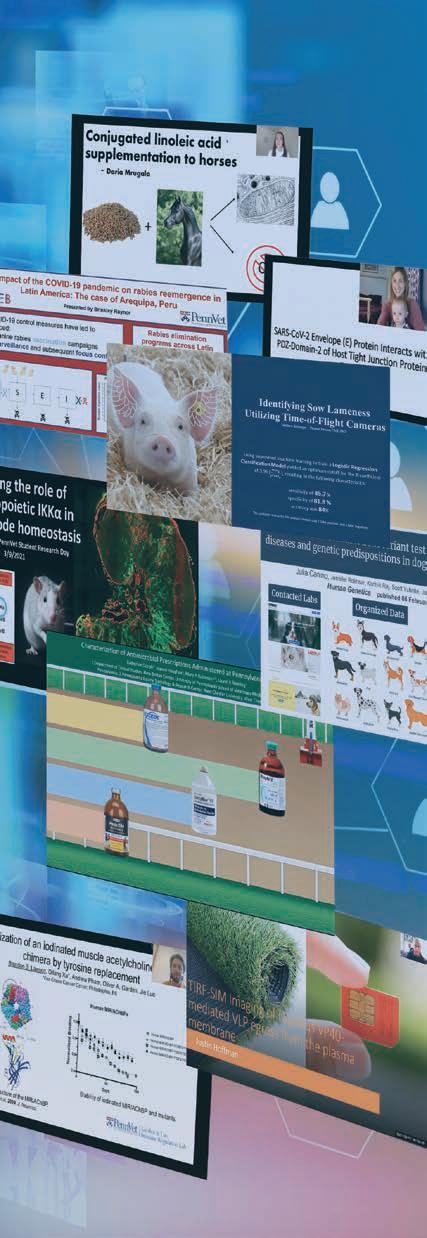
During the daylong virtual event, 43 VMD and VMD-PhD students shared their laboratory, clinical, or field studies research with attendees, showcasing innovation, creativity, and academic achievement. Six students gave oral presentations and 37 students presented posters, in addition to the poster slam video. A panel of faculty judges selected outstanding abstracts for awards of excellence.
Dr. Theresa Alenghat, V’03, PhD’07 , from the University of Cincinnati School of Medicine and Cincinnati Children’s Hospital Medical Center, delivered the keynote address entitled Epigenetic Regulation of the Host-microbiota Relationship .
Dual Degree
VMD-PhD Awards
Jaclyn Carlson
Collagen V Haploinsufficiency
Results in Delayed Healing and Altered Wound Matrix PostInjury in Murine Tendons
MENTOR: Dr. Louis Soslowsky, Perelman School of Medicine
Megan Clark
Remodeling the Electron Transport Chain in Macrophages by a Peptide-miRNA Axis
MENTOR: Dr. Jorge Henao-Mejia, Perelman School of Medicine
Martha Stone
Chemogenetic Activation of Orexin Neurons Accelerates
Emergence from Isoflurane
Anesthesia
MENTOR: Dr. Max Kelz, Perelman School of Medicine
Veterinary Student
VMD
Presenters
Justine Cianci
Qualitative Assessment of Fracture Configuration and Subchondral Bone Pathology in Horses with Lateral Condylar Fractures of MC/MT3
MENTOR: Dr. Kyla Ortved, Penn Vet
Victoria Kranz
Sow Familiarity and Aggression at Post-gestation Mixing
MENTOR: Dr. Meghann Pierdon, Penn Vet
Julianne Nolte
Non-canonical NF- κ B Signaling in Lymphatic Vessels Regulates Immune Homeostasis in the Lung
MENTOR: Dr. Michael May, Penn Vet
40 BELLWETHER SPRING/SUMMER 2021 STUDENT NEWS
Best Poster Awards
Matthew Boulanger, VMD
Identifying Sow Lameness
Utilizing Time-of-Flight Cameras

Matthew Boulanger and Dr. Thomas Parsons. Penn Vet
Eli Braun, VMD
Development of a RT-LAMP Assay for the Detection of SARS-CoV-2 in Companion Animal Samples at Ryan
Veterinary Hospital
Eli Braun, Dr. Jaclyn Dietrich, Dr. Stephen Cole, and Dr. Shelley Rankin. Penn Vet
Brinkley Raynor, VMD-PhD
The Impact of the COVID-19 Pandemic on Rabies
Reemergence in Latin America
Brinkley Raynor, Elvis W. Díaz, Julianna Shinnick, Edith Zegarra, Ynes Monroy, Claudia Mena, and Ricardo Castillo-Neyra. Perelman School of Medicine and Penn Vet.

Ariel Shepley-McTaggart, VMD-PhD
Identification of a SARS-CoV-2
E/Host ZO-1 Interaction: Implications for Tight Junction Damage in Human Lung
Epithelial Cells
Ariel Shepley-McTaggart, Cari A. Sagum, Mark T. Bedford, James Mullin, and Ronald N. Harty. Penn Vet
PENNDEMIC
As a real pandemic raged around the world, Penn Vet and University of the Sciences faculty and students participated in a favorite interdisciplinary annual event: Penndemic. More than 10 faculty and 50 students from multiple programs and schools participated in the four-hour event that simulates an infectious disease outbreak.
Students were first grouped by discipline and collaborated on a short presentation about the role of their field in infectious diseases. They then mixed into interdisciplinary teams and used information from their own discipline to “solve” an outbreak of diarrhea in Philadelphia.
The day concluded with combatting a rumor that Philly tap water was behind the outbreak (it wasn’t) and students pitched social media campaigns to stop the spread of misinformation. Karl Russek from Penn’s Water Center then gave a short talk about healthy water, communities in Philadelphia, and social justice.
WWW.VET.UPENN.EDU/BELLWETHER 41 STUDENT NEWS
THERESA ALENGHAT, V’03, P h D’07
ASKS AND ANSWERS HIGH-REWARD QUESTIONS
Dr. Theresa Alenghat, was certain about one thing as a child: she would one day be a veterinarian who cares for small animals. Then she arrived at Penn Vet. The School changed her vision of what being a veterinarian would mean.

Alenghat’s experience as a VMD-PhD student set her on a path to the research bench, where today she is internationally noted for studying the influence of gut microbes on health and intestinal diseases. While earning her VMD, Alenghat did graduate work with Penn’s Dr. Mitch Lazar, whose laboratory at Perelman School of Medicine studies diabetes and metabolic disease. “I learned in the Lazar Lab that I’m really drawn to the intersection of basic science and pathology,” she recalled.
An anatomic pathology residency at Penn Vet confirmed her trajectory. “While I gained a valuable new set of skills and deep understanding of pathology, I missed being at the lab bench and wanted to focus on testing the unknown,” she said of her decision to return to research after residency.
“My lab’s work now is one hundred percent an extension of what I learned from Penn Vet in combination with amazing graduate and postdoctoral research experiences. Penn Vet was the foundation — my research would not be what it is without the comparative, cross-species and multisystem training I had at the School.”
UNDERSTANDING THE MICROBIOME — HIGH RISK, HIGH REWARD RESEARCH
Today, Alenghat’s research happens at Cincinnati Children’s Hospital Medical Center. She directs a laboratory that investigates how resident microbes
(microbiome) influence epithelial and immune cells and their impact on health, infection, and inflammatory conditions.
“We seek to understand how intestinal microbes communicate with the rest of the body,” she explained. “There’s strong evidence that the composition of these microbes and how they’re contained are disrupted in many inflammatory conditions. Our lab is quite interested in understanding how that happens — and are they actually causative in some of these diseases? Are they driving critical pathways or enzymes in our cells that can predispose to development of disease over time?”
For this work, in 2015, the Pew Charitable Trusts recognized Alenghat as a Pew Scholar for her innovative approach to “high-risk, high-reward research” that can lead to extraordinary findings in bioscience.
42 BELLWETHER SPRING/SUMMER 2021 ALUMNI PROFILE
Dr. Theresa Alenghat
“Our lab enjoys asking broad questions,” she explained. “We explore mechanisms that allow the microbiome to regulate health and disease — and we try to follow the data to new questions. Right now, we’re investigating multiple pathways that seem to be sensitive to different resident bacteria but have not yet been explored.”
RADICAL BREAKTHROUGHS
One of the lab’s recent extraordinary findings was published in the journal Nature last summer. The study shows “good” bacteria, which help us digest food and strengthen our immune systems, are also critical to the healing of damaged intestinal tissues. Most immediately, these findings suggest different bacteria are sensed by the intestine and can help repair tissue damage among people suffering from inflammatory bowel diseases, such as Crohn’s disease and ulcerative colitis.

“We found that resident bacteria break down the diet to a substance that activates an important enzyme in the intestine,” said Alenghat. “This finding is surprising in part because it illustrates how sensitive our health
is to constant interactions with organisms that normally live in our bodies. If we can influence these interactions, we may be able to control many diseases that are impacted by our microbiome or diet.”
A SECONDARY YET PRIMARY ROLE
An acclaimed researcher and author of more than 30 publications cited more than 3,000 times, Alenghat also plays another role, one she didn’t expect but embraces — that of role model and advocate.
A mom of two boys, Alenghat shared, “I didn’t realize until I became a faculty member that the number of women, and especially moms, overseeing independent basic science labs is relatively low,” she said. True to form for someone who loves to address perplexing questions she added, “I’ve become very tuned into this overall issue. I don’t have answers, but the challenge is certainly at the front of my mind these days. It’s a puzzle our field needs to tackle, and I am committed to doing my part by extending opportunities to women in science and amplifying their voices and successes.”
WWW.VET.UPENN.EDU/BELLWETHER 43
“Penn Vet was the foundation— my research would not be what it is without the comparative, cross-species and multisystem training I had at the School.”
Dr. Theresa Alenghat (r) and a member of her lab prepare to conduct research on the microbiome. Courtesy of Cincinnati Children’s Hospital.
FROM THE ALUMNI BOARD
A MESSAGE FROM LIZ BALES, V’00
Vice President of Innovation and Entrepreneurship Penn Vet Alumni Board
In 2014, I learned the number one cause of death for cats is euthanasia and the number one reason for euthanasia is being surrendered to an animal shelter for behavior problems. My mind was blown! Cats’ behavioral needs were clearly defined in the 2013 AAFP Environmental Needs Guidelines. In short, we humans bring cats into our homes, do not meet their needs, and when they react to this deprivation, we euthanize them.
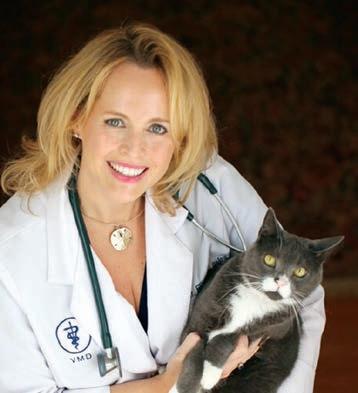
Something had to change.
Then that voice came in my head. “Why don’t you solve it?” That’s the day my career, and my life changed forever. I knew that cats spend up to 80% of their waking hours in nature hunting for mousesized meals. Feeding behavior seemed the most important place to start. I reviewed the criteria necessary to meet a cat’s feeding behavior needs, and drew the first diagram for a prototype to give a cat a way to hunt, catch, and play with six small meals a day. Since then, I’ve sold over 200,000 feeding systems, spoken at veterinary conferences, won awards, appeared on national television and radio, and launched six more products that I collectively call the Feline Behavior Pharmacy. You never know when your life is going to change forever. Do you see a problem without a solution? Maybe you should solve it.
As the Alumni Board vice president of innovation and entrepreneurship, I’m working closely with Penn Vet and our alumni to create connections between ideas and the people who can make them come to life, and to create connections between seasoned veterinarians, big thinkers and students. I hope you’ll help me!
Together we are going to work through some of the biggest challenges facing our profession and innovate solutions. What will the clinic of the future be? How do we handle finance, flexibility, and family? The first challenge is identifying the problem. What are your biggest struggles and concerns? Submit your thoughts on the challenges facing our profession to Liz@DocLizBales.com.
The Alumni Board itself is an innovation. Like any great innovation, it requires new energy and new thinkers. I hope you will consider becoming a part of the board and perhaps even serving in an officer role. To learn more about the alumni board and to explore alumni volunteer opportunities, go to www.vet.upenn.edu/engage. Maybe you can solve it.
44 BELLWETHER SPRING/SUMMER 2021 ALUMNI NEWS
Dr. Liz Bales
CLASS NOTES
1960s
Gustavo D. Aguirre, V’68 , received the 2020 Sanford and Susan Greenberg End Blindness Outstanding Achievement Prize, which distinguishes scientists for their groundbreaking medical contributions to eradicate blindness.
1970s
Susan Horowitz, V’72 , provided veterinary care for small animals in the Groton, Massachusetts, area from 1977 until her retirement in 2020. As one of the first female veterinary graduates from her college, and the founder of one of the first female-owned veterinary clinics, she led the way for the many women who have followed in her footsteps.
Steven Radbill, V’75 , sold his practice, Radbill Animal Hospital, to World of Animals on September 14. He previously sold his Rittenhouse location in 2012. He will be working at their Bethayres office for at least three years and is enjoying working at a multi-doctor practice with many challenges and wonderful staff.
Lloyd “Jock” P. Tate, Jr., V’75 , Diplomate, American College of Veterinary Surgeons, DABLSM, MFH, received the 2020 ACVS Foundation Legends Award for his dedication and contributions to the field of veterinary surgery.
Tate is a North Carolina State University professor emeritus of equine surgery. His most important accomplishment is the introduction of transendoscopic laser ventriculectomy, but he has also developed innovative uses of transendoscopic surgery, including the treatment of guttural pouch tympanites in the foal, the treatment of equine pharyngeal lymphoid hyperplasia and other obstructive masses in the upper airway, and rapid removal of mycotic plaques within the guttural pouch.
Scott Palmer, V’76 , was presented with the American Association of Equine Practitioners 2020 Sage Kester Beyond the Call Award in December. The award recognizes a current or former AAEP member who has made significant and long-lasting contributions to equine veterinary medicine and the community.
1980s
James Dougherty, V’80 , was elected to the Rutgers University Board of Governors, beginning a six-year term on July 1, 2020, after completing eight years on the Board of Trustees, which he chaired during his last year.
Diane Eigner, V’80 , is the 2021 president-elect of the International Association of Animal Hospice and Palliative
Care and chair of its Certification Committee.
Jonathan Leach, V’81 , was selected as Cape Cod’s Best Veterinarian in 2020 by the Cape Cod Times
Salvatore Frasca, V’88 , was appointed director of the Connecticut Veterinary Medical Diagnostic Laboratory.
1990s
Amy Grice, V’90 , a veterinary business consultant in Virginia City, Montana, was appointed treasurer of the American Association of Equine Practitioners.
Scott Weber, V’97 , joined Penn Vet’s Wildlife Futures Program as communications liaison and senior research investigator in August 2020.
2000s
Michelle Mayers, V’00 , was named Veterinarian of the Year at the South Carolina Association of Veterinarians (SCAV) Annual Conference this November. Presented to the veterinarian who has served SCAV, the community, and their fellow veterinarians in a way that exemplifies the highest ideals of the profession. Mayers led a statewide campaign about the importance of pet restraints while traveling in an automobile.
WWW.VET.UPENN.EDU/BELLWETHER 45 ALUMNI NEWS
REMEMBRANCES
1940s
Richard Ainley, V’48 , passed away on October 21, 2020. While he was attending the University of Pennsylvania School of Veterinary Medicine, the Army Medical Corp drafted him to serve the 139th Evacuation Hospital in Europe. As a Surgical Technician (Tech 4), he treated survivors of Ebensee concentration camp in Austria. After returning to school and graduating, he moved to Santa Maria, California, where he purchased a practice, The Pet Hospital. He retired in 1983.
1950s
John Fague, V’51 , passed away on November 23, 2020. He practiced veterinary medicine in Shippensburg, Pennsylvania, and was a past president of the Cumberland Valley Veterinary Association, Pennsylvania Veterinary Medicine Association, American Veterinary Medicine Association, and Cumberland Valley Chapter of the Veterans of the Battle of the Bulge. Fague was also a World War II Army veteran and a Bronze Star Medal recipient. He served in General George S. Patton’s Third Army and in the Battle of the Bulge.
Charles Fager IV, V’55 , passed away on February 26, 2021. Fager owned the Camp Hill Animal Hospital with his brother, Dr. Hummel Fager, V’53. Dr. Fager served as a radio-gunner on a B-17 during World War II in Italy. He received the Air Metal and two Oak Leaf Clusters; the EAME Theater Ribbon, four Bronze Stars and the Distinguished Unit Citation Badge.
Walter F. Loeb, V’55 , passed away on December 24, 2020. After graduating from Penn Vet, he earned an MS at Ohio State University and a PhD at Michigan State University. Loeb was a dedicated veterinary pathologist who specialized in laboratory animal research. His work included founding a pioneering reference laboratory and co-editing a comprehensive textbook used by scientists engaged in animal model research that directly and indirectly contributed to the development of new drugs to treat diseases. A pioneer in toxicologic pathology, he helped to validate the attitude of peer review and good laboratory practice in toxicology research. He was elected councilor for the American College of Veterinary Pathologists (ACVP), president of the
American Society for Veterinary Clinical Pathology, and chairman of the Division of Animal Clinical Chemistry in the American Association for Clinical Chemistry (AACC). He received the AACC Award for Outstanding Contributions to Animal Clinical Chemistry as well as the Barbara Jean Thompson Award for Outstanding Service to the Charles Louis Davis Foundation for the Advancement of Veterinary and Comparative Pathology. In 2005, the ACVP also recognized Loeb as a distinguished member.
Beecher Watson, Sr., V’58 , passed away on September 30, 2020. He began his veterinary practice in Blackstone, Virginia, then joined a practice in Petersburg, and finally started a solo practice in Amelia County, where he specialized in treating dairy cattle. Watson, owner of Amelia Bovine Clinic, worked as a veterinarian until his death. In 1988, the Virginia governor appointed Watson to the Board of Veterinary Medicine, and in 1989 to the Board of Health Professions; Watson proudly served on both boards until 1993. The Virginia Veterinary Medical Association honored Watson in 2012 with the Distinguished Virginia Veterinarian Award. He is survived by his son, Beecher Hartley Watson, Jr., V’82.
46 BELLWETHER SPRING/SUMMER 2021 ALUMNI NEWS
CONTINUED
CLASS NOTES
1960s
Larry A. Schmuck, V’60 , passed away on October 22, 2020. He served the Southern Lancaster County farming community for over forty-two years.
Donald Arthur Gooss, Sr., V’63 , passed away on January 7, 2021. He practiced veterinary medicine at Georgetown Animal Hospital and then Selbyville Animal Hospital for forty-three years. He is survived by his two sons, Donald Gooss Jr., V’93, and John Gooss, V’90.
Albert Barnet V’65 , passed away on March 25, 2021. He worked as a self-employed veterinarian for over 50 years. Albert was a member of the PA Farm Bureau, Somerset County Beef Producers, Somerset County Horse Pullers, and Veterinary for Alaskan Iditarod.
1970s
A. Hunter Wilcox, V’71 , passed away on January 25, 2021. He worked as a veterinarian at the Cherry Hill Animal Hospital from 1972 until his retirement in 2013. In 1976, he became co-owner with his partner and dear friend Charles Chase, V’71. He served on the board of New Jersey Veterinary Medical Examiners, as an officer of the SJVA, and as a
member of other professional veterinary associations. His passion was training and competitively running English pointers in the sport of field trialing. He remained an active member of the English Setter Club of New Jersey, serving as board member since 1977 and as president from 1992 to 1998.
Thomas J. Weiner, V’78 , passed away on December 1, 2020. After graduating from veterinary school, Weiner and his wife purchased a house in Tabernacle, New Jersey, in 1980 and converted a three-car garage into the Animal Clinic of Tabernacle. Their home-based veterinary practice served the Medford/ Tabernacle community for thirty-nine years. Weiner took pride in being a veterinarian who made house calls. He served on Penn Vet’s Board for several years and helped establish the Class of 1978 Endowed Scholarship Fund as well as the Matthew R. Weiner Cardiomyopathy Study Fund at Penn Vet. He is survived by his family, including Cristina Weiner, V’07, and her husband, Tyler Hotaling, V’07.
SEND US YOUR NEWS
Penn Vet graduates achieve remarkable successes every day. Whether you have a new address or are moving forward in your career, announcing an addition to the family, or honoring the life of a fellow alumnus, Alumni Relations wants to hear about it.
Please share your news! Visit the Alumni page of the Penn Vet website, email your news to the alumni office at grovessh@vet. upenn.edu, or write to us at Alumni Relations, Penn Vet Alumni Office, 3800 Spruce Street, Suite 151E, Philadelphia, PA 19104. We may edit submissions due to space considerations.
WWW.VET.UPENN.EDU/BELLWETHER 47 ALUMNI NEWS
DUDLEY ERROL JOHNSTON, BVSC,

Johnston grew up on a rural dairy farm in NSW, Australia and graduated at the top of his class from the University of Sydney as a veterinarian at age 20. As a private practitioner in Hamilton, Victoria, he cared for the prime minister’s sheep flocks and served as official veterinarian of the Melbourne Cup. Johnston, on a scholarship from the Australian government, was later awarded his MVSc degree from the Ontario Veterinary College at the University of Toronto.
Johnston returned to Australia in 1964 and was appointed head of surgery and radiology at the new Melbourne Veterinary School, where he taught and designed the surgical facilities. In 1968, he became a Charter Diplomate of the newly formed American College of Veterinary Surgeons. Johnston spent a sabbatical year at Penn Vet performing large animal surgery. Later, in 1970, he was named to Penn Vet’s faculty as professor of surgery and head of small animal surgery and director of Ryan Hospital in Philadelphia. Johnston developed the first emergency trauma center for small animals, which led to his clinical research interest in wound healing and reconstructive surgery.
Johnston received Penn Vet’s 1979 Norden (now Zoetis) Teaching Award and the Class of 1988 Veterinary Student Government Award for Excellence in Teaching. He published more than 50 articles in refereed journals, and 34 chapters in textbooks, presented more than 200 seminars on surgery in 22 countries, and edited four books. He founded The Compendium on Continuing Education for the Practicing Veterinarian , where he served as editor-inchief for 15 years. Johnston was elected to the Phi Beta Delta Honor Society of International Scholars to recognize contributions to international scholarship and education.
In 1988, Johnston took a sabbatical to teach the first graduating class of the new Koret School of Veterinary Medicine at the Hebrew University of Jerusalem, where he was later offered their first professor of veterinary surgery position. After 21 years at Penn Vet, he retired as emeritus professor and moved his family to Israel in 1991.
During his tenure at Koret, Johnston was instrumental in getting the European College of Veterinary Surgeons (ECVS) to approve a surgical residency program under his direction. The program allowed Israeli surgical residents to become diplomats of the ECVS. In 1997, Johnston was elected president of the ECVS and later served as chair of the Board of Regents.
He is survived by his wife of 45 years, Eileen V’73, and their sons Danvers E. Johnston, PhD, GR’08, and Michael A. Johnston; his daughters Julie, Christina, and Vicki from Australia; 10 grandchildren, and seven great-grandchildren.
48 BELLWETHER SPRING/SUMMER 2021
Dr. Dudley E. Johnston, emeritus professor of surgery, passed away on January 31, 2020, in Wellington, Florida, at 87.
IN MEMORIAM
MVSC, AM, DIP. ACVS, DIP. ECVS
A. GARY LAVIN, V’62
Dr. A. Gary Lavin of Louisville, Kentucky, died on February 27, 2021. He was 83 years old. Born in New Orleans and raised in Arkansas, Gavin earned his VMD from Penn Vet in 1962.
In an interview by the University of Kentucky’s Louie B. Nunn Center for Oral History, Lavin recalled his arrival at veterinary school as a time of advancing surgical techniques in equines. “When I got to Penn, that was the summer that Tim Tam broke down in the [1958] Belmont and he went to the University of Pennsylvania for his surgery,” said Lavin. “I always marked that time, when it made the front page of the Daily Racing Forum for days and weeks that people knew it was possible.”
Lavin’s long career as a practitioner and surgeon was accompanied by a dedication to the sport that led him to accept many roles and challenges. He served terms as president of both the American Association of Equine Practitioners and the Kentucky Thoroughbred Association and was vice-chairman of the GraysonJockey Club Research Foundation and a director of the Keeneland Association.
In 1994, Lavin became the first veterinarian elected to the Jockey Club, and later became a steward of that organization. He also served on the boards of the Thoroughbred Owners and Breeders Association and the Breeders’ Cup. Lavin was a Distinguished Life Member of the AAEP, recipient of the Distinguished Practitioner Award of the Kentucky Equine Practitioners, and the namesake of the Lavin Cup for Equine Welfare established by the AAEP. Recognized for his “myriad of accomplishments, immeasurable regard among peers, and strong commitment to equine welfare management,” Lavin was honored with
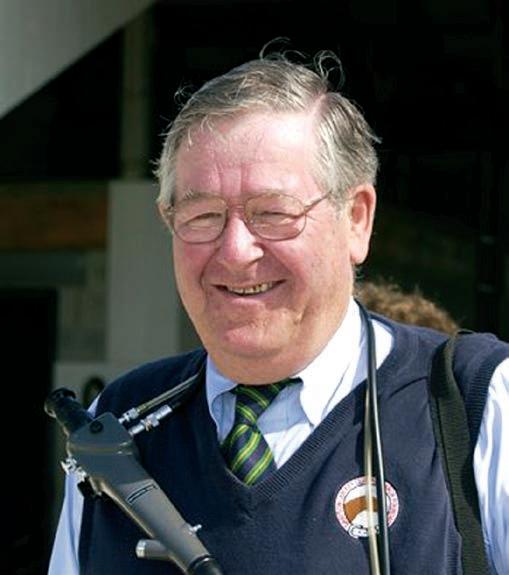
Penn Vet’s 1997 Bellwether Medal for his extraordinary devotion to the School and to the veterinary profession.
Lavin and Betsy, his wife of 60 years, owned Longfield Farm in Goshen, Kentucky, and raised innumerable stakes winners. He is survived by Betsy, two children, and six grandchildren.
Hear more about Lavin’s career in Life’s Work: Reflections on Life in the Equine Industry Oral History Project , produced by the Louie B. Nunn Center for Oral History at the University of Kentucky: kentuckyoralhistory.org (search “Interview with Gary Lavin”).
WWW.VET.UPENN.EDU/BELLWETHER 49 IN MEMORIAM
LAWRENCE OTIS GRAHAM, ESQ.
Board of Advisor Lawrence Otis Graham, Esq., passed away on February 19, 2021 in Chappaqua, New York, at 59.
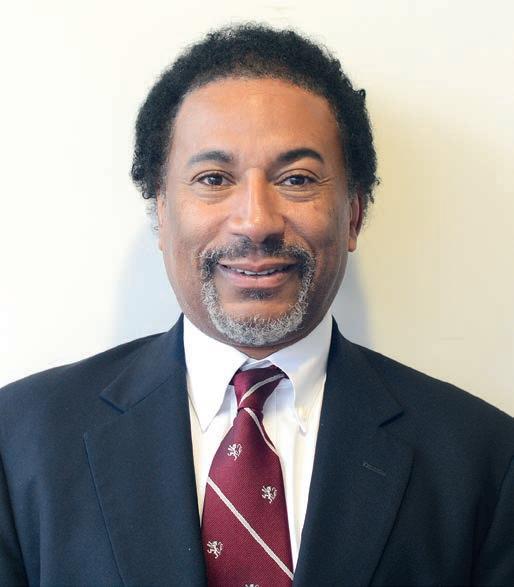
Graham was raised in Westchester County, New York and practiced corporate and real estate law at Manhattan-based Cuddy & Feder, LLP. He was a man of extraordinary brightness, curiosity, and compassion. Graham published 14 bestselling books. His essay Invisible Man appeared in the August 17, 1992 issue of New York magazine chronicling his one-month undercover experience as a country club staffer at an all-white country club. That piece served as the foundation for his 1995 book Member of the Club: Reflections on Life in a Racially Polarized World .
A graduate of Princeton University and Harvard Law School, Graham was an educator and authority on race, class, and politics in America. He taught African American Studies and American Government at Fordham University in the Bronx, New York. Graham brought visibility to contemporary societal and cultural issues as contributing editor at U.S. News & World Report and Westchester magazine, and as a commentator for Westchester’s News12 and Apple podcast’s Justice
“We have been so very fortunate to have known Mr. Graham and to have benefitted from his wisdom, his support, and his undeniable warmth. He was an incredibly passionate man; his energy and focus lit up a room,” said Dean Andrew M. Hoffman. “Mr. Graham joined our Board of Advisors under the leadership of former Board Chair Mindy Halikman Heyer. His belief in Penn Vet was steadfast; and he was particularly excited about our growing potential for societal impact. I am grateful for the wonderful conversations that we had, and the enthusiasm that he imparted to the Board, our leadership, faculty, and students.”
Pace University, in 2014, bestowed Graham the Honorary Doctor of Humane Letters for his commitment to inclusion. Graham’s colleagues at Cuddy & Feder, LLP remarked that his “enthusiastic and energetic community efforts were rooted in his belief that one must give back and make a difference in the lives of people. Larry’s intelligence, vision and sensitivity resonated particularly in his dedication to telling the story of uniquely human experiences and the search for equity for all people.”
Graham is survived by his wife of 29 years, Pamela Thomas-Graham, and their children Gordon, Harrison, and Lindsey.
50 BELLWETHER SPRING/SUMMER 2021 IN MEMORIAM
KAITLYN O’HARA, CVT
Kaitlyn O’Hara, CVT, 27, an anesthesiology nurse at Ryan Hospital, died on February 3, 2021, while trying to rescue a stray cat from a highway in Cherry Hill, New Jersey.

O’Hara joined Penn Vet in 2017 and became an anesthesia veterinary technician. “It’s not surprising that she’s on one of the busiest roads in New Jersey, trying to get a hurt animal off the road. That’s who she was,” said Giacomo Gianotti, the hospital’s head of anesthesia and associate professor of clinical anesthesiology. “And it wasn’t just animals. Everything she did was to help others.”
O’Hara was a volunteer at Randall’s Rescue of Mount Laurel, New Jersey. She devoted her life to helping abandoned cats. “She fostered countless cats,” said O’Hara’s family in a tribute. “She was thought of as the ‘cat whisperer’ for her ability to get these vulnerable, terrified babies to trust her.”
O’Hara is survived by her parents, Joseph and Melissa O’Hara; her fiancé, Edward Bonen, and her three siblings.
To honor Kaitlyn’s memory, her colleagues at Ryan Hospital have established a fund in her name. Visit giving.apps.upenn.edu (search for “Kaitlyn’s Kitties Good Samaritan Fund”) or call Helen Radenkovic at 215-898-2029.
TERESA L. SCOTT, CVT
Teresa L. Scott, CVT, of Swarthmore, Pennsylvania, an anesthesiology service supervisor at Ryan Hospital, died March 7, 2021. She was 63.

Scott spent more than a decade at MBNA America leading travel policy and procurement as Vice President of Corporate Travel Services. Mid-career and driven by a desire to help animals, Scott pursued her Associate Degree from Harcum College’s Veterinary Nursing Program. She joined Penn Vet in 2002, progressing through a series of positions, before becoming supervisor.
Scott made a difference in so many lives over the course of her beautiful life. She will be remembered not only for her strength and magnetism but for her unwavering sense of service and empathy.
“Teresa was such a sweet and compassionate person,” said Ryan Hospital’s Director of Nursing Rosemary Lombardi. “She always made time for you. If you needed help, she was always there to support you. I will miss how she could make me laugh, even on my worst day. Teresa was a very well-regarded member of our Penn Vet family, and she will be so truly missed.”
Scott is survived by her sisters (Kathryn) Lucille Fillman, Connie Fillman, and Sheila Johnson. She is preceded in death by her parents, Kathryn and Earl Fillman.
WWW.VET.UPENN.EDU/BELLWETHER 51
IN MEMORIAM
All events are virtual, unless otherwise noted. For more information and registration for the First Tuesday Lecture series, please visit https://nbcftl21.eventbrite.com.
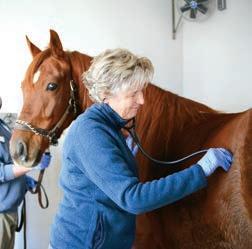
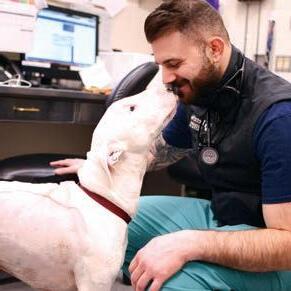
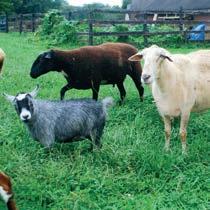
52 BELLWETHER SPRING/SUMMER 2021 PENN VET NEW BOLTON CENTER @NEWBOLTONCENTER @NEWBOLTONCENTER NEW BOLTON CENTER WWW.VET.UPENN.EDU/AG@PENNVET @PENNVETAG @PENNVETAG AGRICULTURE @ PENN VET Follow Us WWW.VET.UPENN.EDU PENN VET @PENNVET @PENNVETSCHOOL PENN VET Last CALENDAR 2021
SEPTEMBER 07 FIRST TUESDAY LECTURE 22-23 (VIRTUAL) PENN ANNUAL CONFERENCE www.vet.upenn.edu/PAC OCTOBER 05 FIRST TUESDAY LECTURE 23 PARENTS &PARTNERS DAY NOVEMBER 02 FIRST TUESDAY LECTURE 05 V’23 WHITE COAT CEREMONY PENNANNUAL CONFERENCE VIRTUAL • 2021 Live & On-Demand Sessions SEPTEMBER 22-23, 2021 www.vet.upenn.edu/PAC
Last
Exceptional Care with Every Touch
We love this picture that photographer Lisa Godfrey snapped of Emergency and Critical Care Veterinary Nurse, Christopher “Chris” Rizzo, LVT, VTS-EVN, with New Bolton Center equine favorite Lola. At both our large and small animal hospitals, veterinary nurses like Chris make up an elite team of accomplished, expert professionals who are integral to our delivery of care. And they showcase something even more extraordinary: the sacred bond between animal and human that drives Penn Vet’s very deep, very personal commitment to all animals, big and small.

WWW.VET.UPENN.EDU/BELLWETHER 53
Word
3800 Spruce Street, Suite 151E
Philadelphia, PA 19104-6044
United Way of Greater Phila. & So. NJ: #50178
Our mission is to train the next generation of leaders to advance healthcare outcomes and access, ensure global health, bolster sustainable agriculture, create and support interdisciplinary career paths, and foster diversity, equity, and inclusion in the profession.

Nonprofit Organization U.S. Postage PAID Bellmawr, NJ Permit No. 1485
Springtime Friends, Foster and Francis


























































